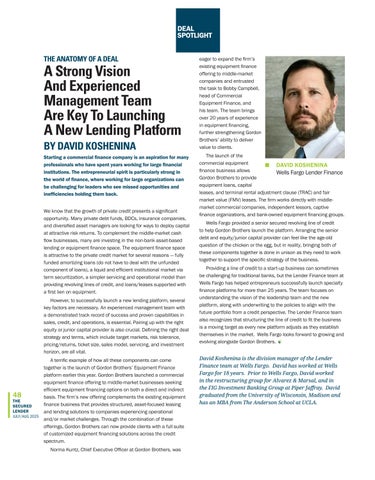

The Deals and Data Issue

Because things aren’t always as they seem
One must comprehend the whole picture before arriving at conclusions.
Tiger’s ABL appraisers and data analysts are never satisfied taking just one look at a problem. They take a second, third, and fourthuntil they see the true picture. Boots-on-the-ground due diligence. Proprietary TigerInsightstm Analytics. $5b/year liquidation expertise.
Take a closer look.

Empowering the SFNet Community to Chart the Industry’s Future
When we launched this edition in 2022, our aim was to spotlight the essential role data plays in helping all of us make smarter decisions in a rapidly changing environment. That goal is more relevant than ever in 2025. The pace of change in secured finance hasn’t slowed—and neither have we.
In this issue, we dig into key industry metrics from our Annual ABL and factoring surveys as well as incorporating metrics from the SFNet Market Pulse and LSEG, all designed to help you gauge where we are and where we’re headed. You’ll also find detailed deal spotlights, offering an inside look at how SFNet members are structuring creative, high-impact transactions in today’s marketplace.
Before we delve into the topics in this issue, we have a lot going on here at SFNet:
Registration opened on July 22 for SFNet’s 81st Annual Convention, November 11–13 in Los Angeles. This year’s theme, Rising to the Challenge, speaks directly to the realities of our time. Whether it’s navigating economic uncertainty, adapting to regulatory shifts, or innovating in a competitive market, our industry is being tested—and responding with resilience. We’re curating a program that goes beyond the headlines to deliver meaningful insights, practical strategies, and the kind of high-impact connections that help you rise to meet whatever comes next.
On September 8, we’re hosting our second Supply Chain Finance Conference in New York City. This is your opportunity to gain actionable insights that will help you adapt to global disruptions, optimize liquidity, boost resilience, and stay at the forefront of SCF innovation. Visit sfnet.com for details and to register.
In 2024, we launched our SFCP certification program. The Secured Finance Certified Professional credential is designed to set the standard for excellence in our industry. I’m excited to report as of this writing we’ve had 9 members qualify to be SPCP certified with 27 currently matriculating and the number climbing rapidly. Be sure to read their profiles in TSL Express . Reach out to Denise Castagna at dcastagna@sfnet.com to learn how you can be next.
Starting on page 28, we feature member deals that illustrate the significant impact secured finance can have on businesses representing a wide range of industries, including a pharmaceutical distributor, a baking company, and a luxury spirits brand.

In a period marked by volatile policy shifts, persistent inflationary concerns, and market recalibrations, SFNet’s June members-only webinar, “2025 Mid-Year Market Pulse: Navigating the Shifting Economic Landscape,” offered much-needed perspective from thought leaders across secured finance, macroeconomics, and credit markets. Drawing from proprietary survey data, sector analyses, and forecasts, the session mapped a complex, but navigable, road ahead for asset-based lenders, factors, and credit professionals. Turn to page 6 for highlights from the webinar.
RICHARD D. GUMBRECHT SFNet Chief Executive Officer
On page 9, we highlight Q1 2025 data from both SFNet and LSEG LPC, which revealed a mixed landscape: one that is marked by cautious optimism, divergent performance between banks and non-banks, and mounting macroeconomic pressures stemming from tariffs, shifting Fed policy, and geopolitical uncertainty.
In a world where global politics and security seem to shift with every headline, understanding the forces behind today’s volatility is more crucial than ever. On page 10, David Chmiel takes you inside the aftermath of 2024’s “Year of Elections,” exploring how voter pessimism, rising populism, and unpredictable leaders are redrawing the map of international risk.
On page 18, David Ebroon of JPMorgan and Jared Zajac of Cadwalader, Wickersham & Taft LLP explore how Non-Loan Party Restricted Subsidiaries are reshaping the risk landscape for lenders. This article reveals how their EBITDA is often included in loan covenant calculations—despite not backing the debt—creating hidden vulnerabilities.
As you flip through this issue, I encourage you to reflect not just on what the data tells us, but on how we can use it to shape the future of our industry. Thank you for being part of this vibrant community—and for everything you do to move secured finance forward.
A MID-YEAR CHECK ON THE SECURED FINANCE MARKET TABLE OF CONTENTS. JULY/AUGUST 2025 VOL. 81 ISSUE 5
COVER STORY

A Mid-Year Check on the Secured Finance Market
In a period marked by volatile policy shifts, persistent inflationary concerns, and market recalibrations, SFNet’s June members-only webinar, “2025 Mid-Year Market Pulse: Navigating the Shifting Economic Landscape,” offered much-needed perspective from thought leaders across secured finance, macroeconomics, and credit markets. 6
FEATURE STORIES
The State of Asset-Based Lending in Q1 2025
As the economic fog of 2025 lingers, asset-based lending (ABL) remains a critical barometer of credit demand, market stability, and lender sentiment. The Q1 2025 data from SFNet and LSEG LPC reveals a mixed landscape: one that is marked by cautious optimism, divergent performance between banks and non-banks, and mounting macroeconomic pressures stemming from tariffs, shifting Fed policy, and geopolitical uncertainty 9 BY SFNET’S DATA, TECH & AI COMMITTEE

Further Reflections on the Year of Elections – Where Are We Now?
In a world where global politics and security seem to shift with every headline, understanding the forces behind today’s volatility is more crucial than ever. 12 BY
DAVID CHMIEL
FEATURED STORY
THE STATE OF ASSET-BASED LENDING IN Q1 2025 P.9
Non-Loan Party Restricted Subsidiaries: A Key Pitfall
Explore how Non-Loan Party Restricted Subsidiaries are reshaping the risk landscape for lenders. This article reveals how their EBITDA is often included in loan covenant calculations— despite not backing the debt—creating hidden vulnerabilities. 18
BY DAVID EBROON AND JARED ZAJAC
Supply Chain Finance in Turbulent Times: A Roundtable Discussion
Members of SFNet’s Supply Chain Finance Committee, including Bryan Ballowe, managing partner, TradeCap Partners; Tony Brown, principal, The Trade Advisory; Alan Eliasof, CEO, Prestige Capital; Bob Grbic, founder and president, Bearbrook Corporate Advisors LLC and Megan Slovak, SVP, underwriting manager, Rosenthal Capital Group, sat down for a discussion about global trade tensions, tariff wars, factoring innovation, and supply chain risk. 22
BY EILEEN WUBBE
Articles
DEAL SPOTLIGHT
Commercial Finance Partners 28
Dwight Funding 30
Franklin Capital 32
Gibraltar Business Capital 33
Hedaya Capital Group 35
JPalmer Collective 37
Mountain Ridge Capital 39
nFusion Capital 41
Rosenthal Capital Group 43
SierraConstellation Partners 44
Utica Equipment Finance, LLC 46
Wells Fargo Lender Finance 48
SFNET MEMBER DIRECTORY
A full list of organizations that are a member of the Secured Finance Network. Please visit their websites to learn more about how they can assist with your working capital needs. 49
PUTTING CAPITAL TO WORK: How Assembled Brands
Helped Janji Scale Its Mission-Driven Running Apparel Brand
Janji is a mission-driven running apparel brand that creates high-performance gear inspired by the places runners explore and the people they meet along the way 54
BY MICHAEL LIPKIN
TOUCHING BASE 1
NETWORK NOTES 4
The Secured Finance Network is the trade group for the asset-based lending arms of domestic and foreign commercial banks, small and large independent finance companies, floor plan financing organizations, factoring organizations and financing subsidiaries of major industrial corporations.
The objectives of the Association are to provide, through discussion and publication, a forum for the consideration of inter- and intra-industry ideas and opportunities; to make available current information on legislation and court decisions relating to asset-based financial services; to improve legal and operational procedures employed by the industry; to furnish to the general public information on the function and significance of the industry in the credit structure of the country; to encourage the Association’s members, and their personnel, in the performance of their social and community responsibilities; and to promote, through education, the sound development of asset-based financial services.
The opinions and views expressed by The Secured Lender’s contributing editors and authors are their own and do not necessarily express the magazine’s viewpoint or position. Reprinting of any material is prohibited without the express written permission of The Secured Lender
The Secured Lender, magazine of the asset-based financial services industry (ISSN 0888-255X), is published 6 times per year (Jan/Feb, March, June, July/Aug, Sept and Nov) $65 per year non-member rate, and $105 for two years non-member rate. SFNet members are complimentary.
Secured Finance Network
370 Seventh Avenue, Suite 1801, New York, NY 10001. (212) 792 -9390 Email: tsl@sfnet.com www.SFNet.com
Periodicals postage paid at New York, NY, and at additional mailing offices. Postmaster, send address changes to The Secured Lender, c/o Secured Finance Network, 370 Seventh Avenue, Suite 1801, New York, NY 10001
Editorial Staff
Michele Ocejo Editor-in-Chief and SFNet Communications Director mocejo@sfnet.com
Eileen Wubbe Senior Editor ewubbe@sfnet.com
Aydan Savaser
Art Director asavaser@sfnet.com
Advertising Contact: James Kravitz
Business Development Director
T: 646-839-6080 jkravitz@sfnet.com
Blank Rome Expands Dallas Office with Addition of Leading Litigators David M. Clem and Megan A. Altobelli
Partner David M. Clem and associate Megan A. Altobelli have joined the firm’s nationally recognized Business Litigation group and Financial Services industry team. As litigators and trial lawyers, Clem and Altobelli focus their practice on complex commercial litigation, primarily representing financial institutions in significant trials and arbitrations.
BofA Names Gabby Hodgson President of Colorado
Bank of America has named Gabby Hodgson, Merrill market executive, as president of Bank of America Colorado. She succeeds Raju Patel who led the market for the past six years and continues as Global Commercial Banking market executive for Colorado.
Charlotte Hogg Appointed Chief Executive Officer of Alter Domus
Charlotte Hogg has distinguished career of over 25 years in financial services, across both the public and private sectors. Hogg succeeds Doug Hart, who has served as CEO since 2019.
Blank Rome Welcomes New Finance
Associate K. Terrell Hutchins in New York
K. Terrell Hutchins has joined the firm’s New York office as an associate in the Finance, Restructuring, and Bankruptcy group. Hutchins focuses his practice on specialty financing, asset-based lending, supply chain financing, and lender financing transactions.
Drmacich Joins Aequum Capital to Lead Growth Initiatives
Based in the Southeast, Bill Drmacich has joined Aequum as head of Originations. In this role, he will be responsible for sourcing new lending opportunities and supporting the strategic growth of origination efforts beyond the greater Midwest.
eCapital Welcomes Jeff Butts as Senior Vice President of Supply Chain Finance to Drive Platform Momentum
Jeff Butts was appointed senior vice president, supply chain finance, within eCapital’s commercial finance division. Based in the Orlando area, Butts has more than 20 years of experience helping suppliers unlock working capital and improve liquidity across complex financial environments.
eCapital Welcomes Second Senior Hire to Support Supply Chain Finance Growth
eCapital Corp. announced the appointment of David Leonard as vice president, supply chain finance, within its commercial finance division. This addition reflects eCapital’s continued investment in scaling its supply chain finance platform and expanding its ability to deliver tailored capital solutions through a focused, enterprise-ready sales approach.
FGI Finance Grows Midwest Presence with the Addition of Bryan Rozum
Bryan Rozum, CFA was hired as managing director. Based in Chicago, Rozum will focus on originating new business opportunities throughout the Midwest for FGI Finance, FGI’s asset-based lending division.
FGI Tech Appoints Jennifer Zimmerman to Lead TRUST™ Client Success Team
FGI Worldwide LLC (“FGI”) announced the hiring of Jennifer Zimmerman as director of Client Onboarding and Success, FGI Tech. Zimmerman will lead worldwide client success efforts for TRUST™, FGI Tech’s credit insurance management software.
Fifth Third Bank, National Association, Names Scott Daigle as North Florida President, Cary Putrino as Region Chairman Scott Daigle succeeds Cary Putrino, who has transitioned into a new role as region chairman in North Florida. As North Florida region president, Daigle oversees the strategic direction and growth of Fifth Third’s commercial banking, wealth and asset management and commercial payments businesses across key markets. Putrino will focus on business development, special projects and brand ambassadorship.
First Bank Names New Chief Credit Officer
First Bank announced the appointment of Larry Jackson as its new chief credit officer. Jackson is based at the bank’s Greensboro, NC office located at 101 N Spring Street. He brings over 21 years of extensive experience in the financial services industry, with a distinguished career focused on credit risk management.
Frost Brown Todd Strengthens Private Equity & Venture Practice with Addition of Partner Ryan Tharp in Denver
Frost Brown Todd (FBT) has added Ryan Tharp as partner in its Private Equity & Venture practice in Denver. Tharp joins FBT with deep experience in partnership and corporate tax matters, mergers and acquisitions (M&A), private placements, corporate governance, and commercial issues.
Goletz Joins Asset Based Lending Originations at Webster Bank
Webster Bank announced Michael Goletz has joined the bank’s Asset Based Lending (ABL) division as managing director, ABL Originations. He will report to David Viggiano, senior managing director, national sales leader ABL at Webster. Based in Indianapolis, Goletz will be responsible for originating and structuring new asset-based credit facilities across the Midwest.
Greenberg Traurig Continues Growth in Texas, Adds Private Equity Shareholder
Sidney Nunez in Houston
Sidney Nunez advises public and private companies, as well as private equity firms, on a broad spectrum of corporate transactions. His experience includes domestic and crossborder mergers and acquisitions, divestitures, joint ventures, restructurings, and financings.
Hyper Valuation Services Hires Mark Stevens to Lead the Newly Launched Diligence Services Division
Hyper Valuation Services (“HVS”), a division of HyperAMS, announced that with the hiring of Mark Stevens as managing director of the newly launched Diligence Services division, it now provides clients with an expanded
range of complementary collateral monitoring services, including field exams and inventory test counts. In his new role at HVS, Stevens will focus on building HVS’ new field exam practice and will work closely with the existing appraisal teams to create synergies and value for clients.
Mayer Brown Further Strengthens Global Mergers and Acquisitions and Private Equity Practice with Aideen Brennan
Aideen Brennan has joined as a partner in the firm’s global Corporate & Securities practice in New York, further strengthening its financial services, mergers and acquisitions (M&A) and private equity offerings. Brennan counsels clients on complex domestic and cross-border transactions, including public and private M&As, joint ventures, co-investments, and early- and late-stage minority investments.
Mitsubishi HC Capital Canada Expands Technology Finance Team, Hires Industry Expert Bojan Janjic
Bojan Janjic has joined as a new strategic account executive for the company’s growing technology division. Working alongside Jim Moschos, director of Technology Finance, Janjic will provide flexible and tailored financing options that help end-users acquire the latest in hardware, software and services at manageable costs.
Structured Transactions Team Joins Morgan Lewis in New York and Philadelphia
Morgan Lewis’s leading structured transactions practice welcomed back Edward J.L. (Jay) Southgate as a partner resident in the firm’s New York office. Southgate represents financial institutions, issuers, and underwriters in private placements of residential mortgage and asset-backed securities with a particular focus on consumer lending and fintech.
Their arrival follows a number of key additions the Chambers Global Band 1 practice has made including Brandon Figg in Washington, DC; David Sylofski in New York; and Dasha Sobornova in London.
Moritt Hock & Hamroff Welcomes 2025 Class of Summer Associates
Moritt Hock & Hamroff is pleased to welcome Sabrina Arfeen, Claudio Diaz, Pacika Guerra, Abla Laallam, Mofiyinfoluwa Shotayo and Hannah Stubbs to its 2025 Summer Associates Program.
Norton Rose Fulbright Welcomes Standout Corporate Partner to Rapidly Growing Chicago Office
Global law firm Norton Rose Fulbright announced that Kyle Gann, a highly regarded corporate lawyer, has joined its Chicago office as a partner in the business practice group and a member of the firm’s transactional and regulatory insurance team.
Republic Business Credit Hires Katie Hay, AVP Legal Analyst
A graduate of Louisiana State University, Katie Hay continued her education to earn a Paralegal Certificate from LSU in 2019. Her career includes significant experience assisting, drafting and reviewing legal cases across all stages in the state of Louisiana. She will report to VP, legal manager Christy Morgan.
Siena Lending Group Welcomes Andrew Kehoe
Siena Lending Group LLC announced the appointment of Andrew Kehoe as director of Originations. Kehoe will be responsible for expanding Siena’s origination efforts and deepening its coverage across the Mountain West region.
SLR Credit Solutions Announces Taylor Stewart Joins as Director of Origination
SLR Credit Solutions (“SLR CS”), is pleased to announce Taylor Stewart has joined as director of Origination. With over 12 years of industry experience, Stewart brings deep expertise in originating, structuring, and underwriting asset-based and cash flow credit facilities for middle market companies.
Mitch Rubin Joins Tiger Group as a Managing Director
Mitch Rubin, a banking professional with 18 years of experience in asset-based
lending, has joined Tiger Group as a business development managing director. The Westchester, NY-based executive will leverage his extensive private equity and banking industry contacts to source opportunities in the metro New York and Boston markets.
Tradewind
Finance Turns 25
Tradewind Finance, an international trade finance provider, is excited to be celebrating its 25th anniversary this year. This milestone commemorates 25 years of serving exporters, importers, manufacturers, and more with innovative liquidity solutions to grow and succeed. Tradewind was founded in 2000 in Germany with the mission to help suppliers bridge cash flow and equip them with the tools to trade securely.
US Capital Global Expands West Coast Operations with Erick G. Schenkhuizen Appointed Vice President in Newport Beach In his new role, Erick Schenkhuizen will lead the delivery of customized debt and equity financing for middle-market businesses, as well as customized wealth management and investment solutions for high-networth individuals, affluent families, and independent RIAs in the U.S. and globally.
Dan Gioia Joins Asset Based Lending Originations at Webster Bank
Dan Gioia has joined the bank’s Asset Based Lending (ABL) division as senior managing director, Third Party and Large Corporate ABL Origination. He will report to David Viggiano, SMD national sales leader ABL at Webster. Based in New York, NY, Gioia will cover the ABL syndicated market across the U.S.
White Oak Commercial Finance Hires
Brendan Harrison as Managing Director, Originations
Brendan Harrison will leverage his deep experience in asset-based lending (ABL) origination to further bolster WOCF’s leading middle market ABL platform. Prior to joining WOCF, Harrison was a senior vice president at Citizens Business Capital, where he was responsible for originating ABL transactions across the Mid-Atlantic and Northeast regions.

A Mid-Year Check on the Secured Finance Market
BY SFNET’S DATA, TECH & AI COMMITTEE
In a period marked by volatile policy shifts, persistent in ationary concerns, and market recalibrations, SFNet’s June members-only webinar, “2025 Mid-Year Market Pulse: Navigating the Shifting Economic Landscape,” offered much-needed perspective from thought leaders across secured nance, macroeconomics, and credit markets. Drawing from proprietary survey data, sector analyses, and forecasts, the session mapped a complex, but navigable, road ahead for asset-based lenders, factors, and credit professionals.
Macroeconomic Overview: Strength in the Hard Data, Anxiety in the Soft Rob Wescott, president of Keybridge LLC, opened the webinar by highlighting the split between robust hard data and increasingly shaky soft indicators.
On one hand, the U.S. labor market remains resilient—adding 139,000 jobs in May—and industrial production is holding above 2024 levels. GDP growth, while volatile, is projected to hover near 1.7% for the year, reflecting moderate expansion despite multiple economic headwinds.
But underneath the surface, economic policy uncertainty has surged to record highs, and the Federal Reserve has repeatedly invoked the specter of stagflation. Political gridlock and foreign trade conflicts continue to muddy the waters. Recent policy actions—including renewed tariffs on Chinese imports—have sent ripples through supply chains, prompting businesses to reassess procurement strategies and pricing models.
Tariffs remain a wildcard. Since January 2025, average U.S. tariffs have spiked sevenfold to over 15%, driving pre-emptive import surges in Q1 and escalating inflation fears. Wescott noted a sharp divergence in consumer behavior: higher-income Americans—buoyed by the stock market and home equity— continue to spend, while lower-income households are increasingly reliant on minimum credit card payments.
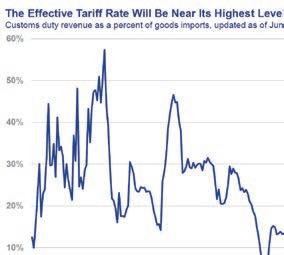

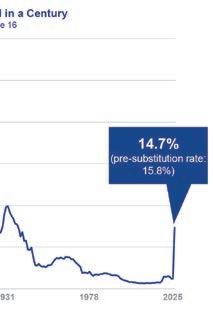
Sector Outlook: A Tale of Two Consumers
Jeff Jensen, also from Keybridge, emphasized the distortion in retail activity. March retail sales surged +1.5% month-overmonth as consumers rushed to frontload purchases ahead of tariff implementation. However, April and May reversed sharply, suggesting a pullback in discretionary demand. While restaurant spending has remained stable, categories like electronics and travel have weakened significantly.
This divergence is reflected in consumer confidence metrics. The Conference Board’s Consumer Confidence Index dropped for the third straight month in May, highlighting growing concern among middle-income households. Despite this, personal savings



rates have remained flat, and delinquencies on revolving credit accounts are inching upward.
Wholesale inventories rose, but sales kept pace, keeping inventory/sales ratios balanced. Producer Price Index (PPI) subcomponents tied to tariff-sensitive goods—steel, metals—are seeing pricing pressures, although broad inflation remains muted for now.
Manufacturing sentiment, as measured by PMI and the National Association of Manufacturers, hovers just below contraction territory, yet actual industrial production remains solid. Employment in the sector, however, continues to experience a slow erosion. Jensen suggested that firms are relying more heavily on productivity gains and automation to offset labor constraints.
Credit Demand: Softening, But Not Collapsing
While banks report diminished C&I loan demand, the broader picture is one of caution, not collapse. SFNet’s Q1 2025 ABL survey revealed slightly rising client utilization, potentially reflecting pre-tariff borrowing. The ABL Confidence Index did decline post“Liberation Day”, a marker that registered sentiment before the U.S. softened its stance on Chinese tariffs.
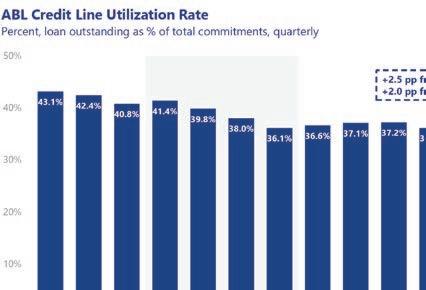


Commercial lending officers in the Federal Reserve Board’s Senior Loan Officer Opinion Survey (SLOOS) echoed this cautious tone. Demand for credit among small- to mid-sized firms has declined modestly, while credit standards remain tight. The result: fewer new originations, but an uptick in utilization of existing lines.
Factoring, interestingly, remains stable. The February 2025 Factoring Confidence Index showed resilience, attributed to small businesses tightening cash cycles and seeking fast access to liquidity. Anecdotal evidence also suggests a mild uptick in receivable aging. Industry insiders report that non-recourse factoring is regaining popularity, as businesses attempt to de-risk their cash flow strategies.
Pricing and Spreads: A Reversal Toward Credit Quality
Spreads are holding firm across most bank portfolios, but there is a flight to quality underway. Ken Yager of Newport Advisors described the current environment as a “tightening strike zone”— where banks still aggressively lend to strong credits, but show reluctance toward edge-case borrowers, especially in tariffsensitive sectors.
In the ABL market, survey data shows a minor drop in committed credit lines in Q1 2025, though Barry Bobrow of Regions Business Capital believes seasonal effects and data participation rates may account for the dip. Still, spreads are holding up. New deals are often pricing in the TSOFR+175–225 basis point range, depending on collateral quality and borrower size.
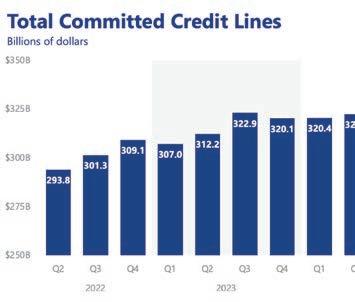
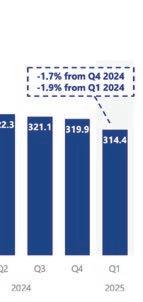
Meanwhile, smaller lenders and nonbanks are beginning to show more pricing flexibility, offering below-market rates to win high-quality credits—a trend that could compress margins for traditional bank participants in the quarters ahead.
CLO Market at an Inflection Point
The webinar hinted at the broader market’s liquidity posture. CLO managers—critical to leveraged loan demand—are facing yield compression from both ends. With spread tightening and uncertain policy direction, many CLOs are extending warehouses or delaying issuance. If Fed cuts materialize in late 2025, it may relieve some pressure, but volatility remains a near-term challenge.
The CLO market, which now exceeds $1.1 trillion in U.S. AUM,
remains a critical pillar in leveraged finance. However, rising concern over underlying loan quality, especially among B-rated tranches, is prompting some investors to diversify away from primary deals. Increased scrutiny from both internal risk teams and regulatory bodies may slow issuance through Q3.
Treasuries and Fed Watch: The Duration Dilemma
Markets currently price in two 25bp rate cuts by year-end 2025, with the first likely arriving in September. Yet the Fed remains cautious, balancing softening consumer sentiment against persistent inflation in service categories. The internal Fed “dot plot” also reflects a more hawkish stance compared to March.
Jensen underscored that rate movement expectations are more delayed than derailed. With import-driven inflation risks and mixed consumer sentiment, policy normalization will be gradual. The Fed’s ability to engineer a soft landing hinges on inflation not reaccelerating from tariff pass-through effects.
For secured lenders, rate uncertainty adds complexity to deal structuring. Lenders are increasingly using shorter tenors and tighter covenants to manage duration risk. Borrowers, meanwhile, are eyeing the potential for refinancing in a lower-rate environment and are eager to lock in flexibility wherever possible.
A Resilient, But Redefined, Market
Portfolio performance remains within historical norms. While charge-offs are rising, they still sit near long-term averages. SFNet’s Q1 data showed a jump in non-accruals, though largely driven by a few outliers. Most lenders report stable performance, and interest in deploying capital remains strong—particularly among nonbanks.
Private credit’s continued encroachment into bank territory is also reshaping the competitive landscape. Direct lenders are increasingly offering ABL-like structures with looser covenants and faster execution—attracting sponsors and family-owned businesses that might otherwise seek traditional bank funding.
Despite policy headwinds, the webinar consensus suggested that the U.S. secured finance market is navigating the turbulence with a cautious but forward-leaning posture. As Yager aptly summarized, “The banks aren’t retreating— they’re just throwing to a much narrower strike zone.”
As summer unfolds, all eyes will remain on tariffs, inflation gauges, and capital formation. The data may be noisy, but the directional indicators suggest a market recalibrating around fundamentals, not falling apart.
To participate in SFNet’s upcoming ABL and Factoring surveys, contact Aydan Savaser at ASavaser@sfnet. com. Your input ensures stronger data—and a stronger industry.
This article was written with the assistance of ChatGPT.
The State of Asset-Based Lending in Q1 2025

BY SFNET’S DATA, TECH & AI COMMITTEE
As the economic fog of 2025 lingers, asset-based lending (ABL) remains a critical barometer of credit demand, market stability, and lender sentiment. The Q1 2025 data from SFNet and LSEG LPC reveals a mixed landscape: one that is marked by cautious optimism, divergent performance between banks and non-banks, and mounting macroeconomic pressures stemming from tariffs, shifting Fed policy, and geopolitical uncertainty.
Market Volume Snapshot: ABL Holds Steady Amid Volatility
According to LSEG LPC, syndicated ABL volume reached $22 billion in Q1 2025 across 58 deals, a 29% yearover-year increase. While flat compared to Q4 2024, issuance was in line with the decade-long historical average (excluding the anomalous spike in Q1 2023). The key driver of growth? Refinancing activity, which accounted for 70% of total issuance at $15.4 billion. New money lending jumped 185% YoY to $6.7 billion, now comprising 30% of total issuance— more than double its 14% share in Q1 2024.


Source: LSEG LPC , Q1 2025 Syndicated ABL

However, the divergence between corporate and sponsorbacked issuance is notable. Corporate ABL borrowing surged 63% YoY to $15.2 billion, while sponsor-backed ABL volume dropped 11% to $6.9 billion. Sponsored new money loans plummeted to $452 million—the lowest first-quarter total on record—comprising just 6.7% of new money issuance.
SFNet Survey: Utilization and Outstandings Rise, but Confidence Slips
SFNet’s Q1 2025 ABL Participant Survey, which includes both syndicated and non-syndicated deals, paints a more granular picture. While total commitments dipped slightly (-1.7% for banks, -2.2% for non-banks), outstandings grew for both groups (+5.1% for banks, +4.4% for non-banks). Utilization rates rose to 38.2% for banks (+2.5 percentage points QoQ) and 51.3% for non-banks (+3.2 pp).
Yet, lender confidence waned significantly. The SFNet Lender Confidence Index fell into neutral territory: banks at 49.1 and non-banks at 52.5. Expectations for general business conditions dropped sharply for both groups amid concerns about tariffs and supply chain unpredictability. Portfolio
performance expectations declined, particularly for banks (-22.2 pts to 39.1), although criticized and classified loan ratios slightly improved.
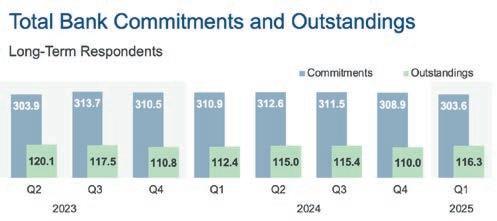
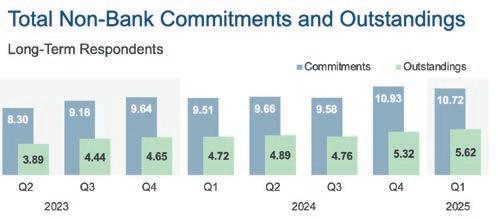
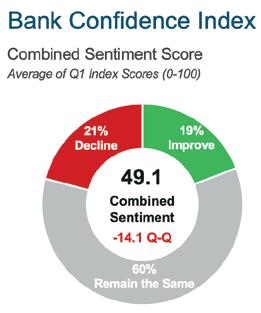
Pricing Trends: Spreads Widen, Quality Commands Premiums
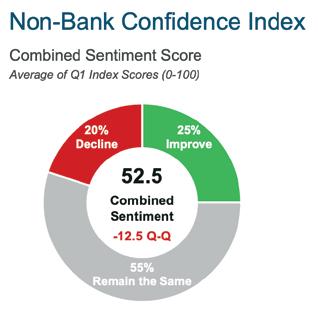
The average drawn spread for syndicated ABL loans climbed to TSOFR+195 bps in Q1 2025, up from 184 bps in Q4 2024. Non-retail spreads widened to TSOFR+198 bps, while retail spreads narrowed to TSOFR+163 bps—a sharp drop from 225 bps in the previous quarter. Spread dispersion remained significant: 45% of deals priced at or below TSOFR+150 bps, and nearly one-third above TSOFR+225 bps. These figures underscore a market bifurcation: top-tier borrowers are commanding better terms, while weaker credits face steeper pricing and more scrutiny.
Deal Purpose and Sector Trends: Corporates Drive General Purpose Lending
In terms of loan purpose, general corporate needs continued to
dominate, comprising $19.2 billion or 83% of Q1 volume. M&A financing accounted for 8.8%, while DIP/exit financings totaled $1.85 billion. Wholesale, retail, and construction led in sector issuance, with wholesale commanding nearly $5 billion.
Economic Backdrop: Tariffs, Trade, and the Fed’s Crossroads
The broader economic picture, as outlined by KeyBridge Research in the SFNet report, is murky. The U.S. economy contracted by 0.2% in Q1 2025 due to a tariff-driven import surge. While consumer and business spending remained healthy, net exports detracted 5.2 percentage points from GDP. Early Q2 data suggests a rebound, but trade policy remains a wild card. The Fed faces a delicate balance: keep rates elevated to combat future tariff-related inflation or cut rates to preempt labor market softness.
Despite falling inflation (headline CPI at 2.4%, core at 2.8% YoY), the central bank is unlikely to move quickly. Retail sales declined in April and May, and business confidence remains shaky. SFNet respondents highlighted weak inventory management and uncertain demand as persistent borrower pain points.
Adaptive, Disciplined, and Prepared Q1 2025 reaffirmed the ABL industry’s ability to adapt to macroeconomic distortion while maintaining strong fundamentals. As the industry eyes a potentially more volatile second half of the year, one thing is clear: ABL lenders are proceeding with heightened caution, but not retreat. The secured lending sector remains ready—not just to endure a slowdown, but to capitalize on opportunity.
This article was written with the assistance of ChatGPT.

The broader economic picture, as outlined by KeyBridge Research in the SFNet report, is murky. The U.S. economy contracted by 0.2% in Q1 2025 due to a tariff-driven import surge. While consumer and business spending remained healthy, net exports detracted 5.2 percentage points from GDP.
Forward Outlook: Storm Clouds or Strategic Opportunity?
Looking ahead, lenders anticipate stable but constrained conditions. New originations may lag until tariff clarity and Fed direction improve. However, ABL remains well-positioned as a reliable structure in uncertain times. Corporate borrowers— particularly those with inventory-driven business models— will continue to rely on ABL as a flexible tool amid macro crosswinds.
Private credit’s continued encroachment into traditional ABL territory remains a structural trend to watch, especially as sponsor-driven activity remains muted. With liquidity abundant in the private markets and clubbed deals gaining traction, the competitive landscape is evolving.

Further Reflections on the Year of Elections – Where Are We Now?
BY DAVID CHMIEL
In a world where global politics and security seem to shift with every headline, understanding the forces behind today’s volatility is more crucial than ever. This article takes you inside the aftermath of 2024’s “Year of Elections,” exploring how voter pessimism, rising populism, and unpredictable leaders are redrawing the map of international risk. Discover why businesses and analysts alike must stay agile in this era of relentless change.
Writing about the current global political and security environment puts me in mind of the Greek legend of Sisyphus, the prince who was condemned to spend eternity pushing an enormous boulder up a steep hill, only for it to roll back to the bottom every time he approached the summit. Such is the relentless pace of change in our world that, just when you think events have achieved something approaching a steady-state equilibrium, something new arises to alter one’s perspective fundamentally. The boulder rolls back down the hill and you trudge downwards to commence the analytical process all over again. Nevertheless, it is vital to adopt a longer-term perspective and to question assumptions made about the future direction of global political and economic events.
The forces driving that relentless pace of change are influenced, in no small part, by the decisions made by voters in elections around the world in 2024. The fact that an estimated half of the world’s population live in countries that held some form of national election last year led to it being dubbed “The Year of Elections” and when 2024 ended, the global political landscape looked remarkably different than it did at the year’s start. In many of those elections, control of governments and legislatures changed outright. In others, incumbent leaders and parties retained power, but often with reduced majorities that forced them into coalitions with other parties, thereby constraining their mandates and injecting additional uncertainty into political analysis.
At the end of last year and the beginning of this year, I wrote a pair of articles for The Secured Lender looking at the immediate aftermath of “The Year of Elections.” Not surprisingly, much has changed since. President Donald Trump took office as the 47th president of the United States and set about shattering long-held assumptions about US domestic and foreign policy, not least in his announcement of “Liberation Day” tariffs targeting most countries around the world. Voters have continued to go to the polls albeit in at least two cases – Canada and Australia – previously unpopular governments managed to secure re-election amidst the economic uncertainty and bursts of nationalism unleashed by US trade policy. India and Pakistan appear to have averted a major war in South Asia, the war in Ukraine rumbled on and the conflict in the Middle East threatened to expand as Israel and then the US attacked Iran’s nuclear facilities. At the risk of embarking on another Sisyphean climb up the mountain, it seems as good point as any to asses these recent developments and consider what further insights can be gleaned in the aftermath of “The Year of Elections”.
Perennial Voter Pessimism and the Turn to Populism
One striking feature of last year’s elections was that many, particularly
in G7 member states, were held against a backdrop of considerable pessimism among voters. This was a key reason why so many incumbent administrations failed to secure re-election. Voters sought change in the hopes that new governments would address their underlying economic worries. In polling conducted by Ipsos across all G7 member states in April 2024, this economic pessimism was evident. In both Germany and the United States, only 36 percent of respondents categorized their national economic situations as either “very good” or “somewhat good.” The results were worse in the remaining five G7 members –Canada, France, Italy, Japan, and the United Kingdom. Contrast this to April 2019 when similar polling by Ipsos found that 76 percent of Germans and 64 percent of Americans rated their national economies as “very good” or “somewhat good.” The intervening half decade was brutal on economic confidence.


Since that survey was conducted in April of last year, voters in six of the seven G7 economies went to the polls in national elections – Italy being the exception. In Germany, the UK and the US, the incumbent parties were ejected from office altogether. In Canada and Japan, governing parties lost seats in national legislatures and in France President Macron’s Ensemble pour la République lost control of the National Assembly altogether. Interestingly, however, there has been little improvement in economic confidence since. Except for Canada, where it increased slightly, and the US, where it remained constant, polling by Ipsos in May of 2025 found that economic confidence declined further across the G7 from levels recorded last April. Without any sort of meaningful improvement in peoples’ perceptions of their economic prospects, that malaise has the potential to fuel further political volatility across some of the world’s key industrial economies. President Macron of France admitted this himself when, in a year-end interview, he said that his decision to call snap elections for the National Assembly created more problems than it solved.
To be fair, events of the intervening period have done little to boost economic optimism. Uncertainty over whether the Trump administration would follow through with tariff threats has been a contributor to global economic uncertainty as has the risk that conflicts in the Middle East and elsewhere could impact global trade and energy flows. As a result, businesses have mitigated against this uncertainty by conserving cash, cutting costs and restricting investment where not wholly necessary. This, in turn, has fomented further political volatility
DAVID CHMIEL
Global Torchlight
in many affected countries.
In the UK, Labour Prime Minister Sir Keir Starmer has had the shortest of political honeymoons despite winning a landslide victory last July. Efforts to curb government spending through measures such as welfare reform prompted major rebellions within his own party and recently forced Starmer into a humiliating political U-turn that has left his government scrambling to fill holes in public finances. Further tax increases – building on ones announced in the Labour Government’s first budget last year – are now almost inevitable. The main political beneficiary of this is not the opposition Conservative Party – still largely vilified after its 14 years in government –but the insurgent, populist Reform Party, which only secured its first seats in the House of Commons in last year’s election. At present, Reform benefits from being the party of protest – a home for disaffected Conservatives as well as Labour voters who are more conservative on issues such as immigration, law and order and the UK’s exit from the European Union. But pressure will build on Reform’s leader, Nigel Farage, to present a coherent policy agenda setting out how he would govern the country given that his party now consistently leads opinion polls. Reform performed very well in UK local elections in May – taking outright control of a number of municipal authorities – and the next test will be how it performs in power. Failure to affect real change could staunch the party’s momentum with voters but success in addressing local issues could pave the way for yet more electoral victories.
not dissimilar from those seen in many other industrialized economies in Europe and North America relating to issues such as immigration and crime. As with the UK, public frustration with establishment political parties has caused voters to look to populist alternatives on both the left and right. This risks upending the largely two-party political consensus that has prevailed in Germany for decades. A failure by Merz to address underlying economic and social concerns could further fracture the country’s politics going forward and fuel yet more uncertainty about the future direction of the country’s economic policy.
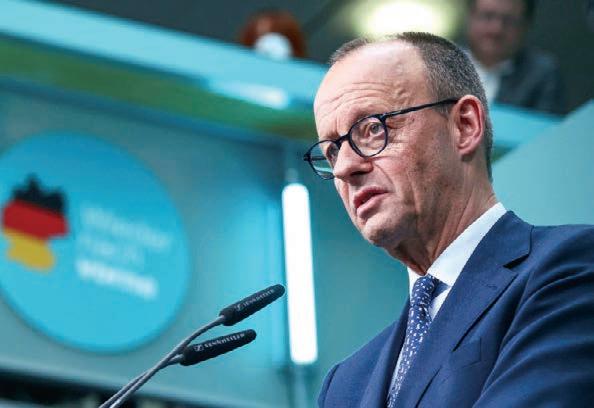
The
newly elected German Chancellor, Friedrich Merz, faces challenges not alto -
gether dissimilar
from
those in the
UK.
As was
previously noted, economic
confidence
has collapsed in Germany over the past half decade owing to a host of factors ranging from weaknesses in the country’s once-formidable export-reliant manufacturing sector to weaning the German economy off dependence on cheap energy from Russia.
The newly elected German Chancellor, Friedrich Merz, faces challenges not altogether dissimilar from those in the UK. As was previously noted, economic confidence has collapsed in Germany over the past half decade owing to a host of factors ranging from weaknesses in the country’s once-formidable export-reliant manufacturing sector to weaning the German economy off dependence on cheap energy from Russia. Germany also confronts social policy challenges
Earlier this year, Canada provided something of an exception to this trend of rejecting incumbents. Under the leadership of former Prime Minister Justin Trudeau, the governing Liberal Party was deeply unpopular with the Canadian public. The opposition Conservative Party of Canada (the CPC) under leader Pierre Poilievre had a commanding lead in the polls. The Liberals ousted Trudeau as leader earlier this year and replaced him with the technocratic Mark Carney, former Governor of the Bank of Canada and the Bank of England. Amidst multiple threats from the Trump administration both economic – in the form of tariffs – and rhetorical –in the form of repeatedly referring to Canada as the “51st State”, Carney played upon both his experience and heightened nationalism among certain segments of the Canadian population to eke out a win for the governing Liberals in April’s federal election. But this surprising result should not be reviewed as an outright rejection of the CPC’s policy platform. Rather than see its
support collapse during the campaign, the CPC secured its largest percentage of the vote in nearly forty years and the Carney victory was owed largely to the near-total collapse in support for the left-of-center New Democratic Party. Moreover, polling shows disparate gaps in political support and issue prioritization across age groups. Older Canadians prioritized standing up to the Trump administration as their key concern
and favored Carney’s Liberals accordingly. Younger Canadians cited longer-term issues such as housing and job creation as key worries and were more likely to vote for the CPC. As with other industrialized economies, Canada faces considerable structural challenges to the economic growth and security Canadians took for granted for decades. A failure by the politically inexperienced Carney to address these concerns could have reverberations the next time Canadians go to the polls, particularly if the spectre of Trump administration threats abates.
Tariffs, Trade and National Security
For businesses concerned about the effects of political events on their operations and profitability, the critical risk lies not in decisions taken by voters in ballot boxes, but how leaders and parties put electoral mandates into practice. The simple reality is that what is promised on the campaign trail is often not what is done in practice. There are always exceptions to the rule and one can arguably be found in President Trump’s trade policy. Trump’s campaign rhetoric on trade was decidedly protectionist and he had adopted such an approach to trade in his first term as well. Rather than moderating his position, President Trump’s actions have arguably been more radical than many predicted. The “Liberation Day” tariffs announced in April do not focus on particular sectors nor do they distinguish between ally and adversary. They have largely universal application.
One of the major challenges for US and international businesses has been the sheer volatility of global trade policy changes since January. Tariffs are announced and then just as quickly paused to allow time for bilateral negotiations, only to be reinstated if deals are not reached. This applies not just to US trade policy, but also to the retaliatory measures adopted by foreign governments in response. Nor are these disruptions confined simply to tariff rates. While some countries have implemented countervailing tariffs against US exports, others have sought alternate ways of seeking leverage in negotiations with the US administration and adopted non-tariff measures such as banning exports of critical minerals or barring US companies from bidding on procurement contracts with foreign governments. We may talk about the risks of a global trade war, but we arguably confront the risk of broader economic warfare if policies and responses are not carefully calibrated. Additional uncertainty comes from the fact that many of the Trump administration’s tariffs are being challenged in the courts and at the World Trade Organization. The overall regulatory landscape may remain unsettled for some time yet and that makes it harder for businesses to plan longer-term. The consequential battening down of hatches risks further economic insecurity and, with it, political volatility. The vicious cycle continues.
Another complication arises from the fact that trade can no longer be decoupled from a volatile international security environment. President Trump has been openly critical of countries – particularly fellow NATO members – that have failed to meet the organization’s prescribed minimum levels
of defense spending. That is a long-standing grievance and President Trump is not the first US president to accuse allies of failing to carry their weight on mutual defense – although he does so much less obliquely than his predecessors. This was already a point of contention when NATO members were expected to commit 2 percent of their GDP to defense spending and it is made more acute from the expectation that this should rise to 3.5 percent or even 5 or 6 percent. It is, therefore, not particularly surprising that President Trump is now tying trade relations with NATO allies to their commitments on defense spending. In late June, when attending the NATO Summit in Brussels, President Trump singled out Spain’s failure on this account and threatened “to make them pay twice as much” in negotiations on a trade deal. This will have domestic political implications in countries targeted by President Trump. With the national treasuries of most industrialized economies already stretched, any increases in defense spending will potentially need to be met either with commensurate spending cuts or tax increases. For example, in December 2024, a survey by YouGov found that only 26 percent of Spaniards felt Spain was spending too little on defence. As President Trump ties trade to international security, many governments may find themselves dealing with recalcitrant domestic populations if they seek to realign domestic spending priorities to avoid punishing economic consequences from tariffs.
International security is particularly relevant when assessing the prospects for any meaningful trade deal between the US and China. The two countries remain strategic competitors whose foreign policy and national security interests seem to be increasingly at odds with each other. Concerns about overdependence on manufacturing facilities located in China led many multinational companies to diversify production through a combination of “nearshoring” or “friendshoring,” but that realignment is now further complicated by the Trump administration’s targeting of both allies and adversaries for tariff increases. There are indications that the US and China may be dialling back the tit-for-tat escalation of economic measures against each other – perhaps recognizing the mutual economic damage resulting therefrom. In early July, the two countries announced an agreement to lift export restrictions on certain items deemed essential for industrial production. But any sort of stabilization in US-China trade relations remains subject to a host of different factors and cannot be taken for granted. Moreover, it is thought that hawks within the Trump administration will continue to pressure the President to prioritize geopolitical and national security considerations in reaching a comprehensive bilateral trade deal.
All of this comes as President Trump signed the One Big Beautiful Bill Act into law on the 4th of July, permanently extending some of his first-term tax cuts and implementing a host of other measures from phasing out clean energy tax credits to raising the debt ceiling and increasing defense spending. It remains to be seen the degree to which these
measures stimulate the US economy by potentially counteracting trade-related uncertainties and whether any US economic revival has a consequential effect on growth in the wider global economy. The clock is now ticking towards the 2026 midterm elections which will put these measures to the test and see whether Americans are prepared to let Republicans maintain control of Congress as well as the presidency or whether a divided government – with all of the uncertainty that entails – will be the order of the day once again.
The Risks of Escalating Conflict
Apart from domestic pessimism, last year’s elections also took place against the backdrop of the most volatile international security environment in decades. Remarkably, however, foreign policy was largely not a decisive factor in how voters cast their ballots in many of those elections. While President Trump and Vice President Harris presented very different visions about the role of the US in the world, domestic policy issues such as taxation, immigration and law and order arguably played a greater role in last fall’s presidential campaign. In other elections in the UK, EU member states and elsewhere, foreign policy was seemingly not a factor at all. Where it did crop up, it was largely in the context of how governments should adapt to a world in which the US disengaged from international affairs.
The global security framework remains highly unpredictable. Earlier in 2025, there were fears of a new regional conflict erupting as India and Pakistan threatened war in the wake of a terrorist attack in Kashmir – a risk made even more concerning by the fact that both countries are nuclear-armed powers. Meanwhile, the ongoing conflict in the Middle East took a dramatic turn when Israel commenced Operation Rising Lion by attacking Iran’s nuclear facilities together with numerous Iranian military command and control capabilities, leading to Iranian retaliation against Israel. This was followed on June 22nd by Operation Midnight Hammer – the attacks by US Air Force B2 bombers on Iranian nuclear facilities at Fordow, Isfahan and Natanz. Later in June, Iran and Israel agreed to a ceasefire, but the region remains only one violation away from renewed conflict.
Quite remarkably, this has diverted a lot of media attention away from the ongoing war in Ukraine. In June, the UK Ministry of Defence estimated that more than one million Russian troops have now been killed or injured since the commencement of Russia’s full-scale invasion of Ukraine in 2022 and Ukrainians continue to live with the risk of Russian attacks on urban areas as well as military targets. A perennial question is whether President Trump will finally lose patience with the absence of any conciliation by Russia that would progress his campaign promises to bring the war in Ukraine to an end. After pausing deliveries of weapons to Ukraine, the US announced in July that it would recommence those supplies. However, in keeping with his inclination to tie all things to trade, President Trump appeared ready to increase economic pressure on countries that continued to support Russia
although it remains to be seen how extensive such measures would be, if implemented.
It remains remarkable that global markets are relatively sanguine about the current scale of conflict in the world and despite the levels of horror and suffering witnessed by those who are living in these conflict zones. That should not, however, engender complacency within businesses since the risk remains of further conflict events that could affect global economic conditions more fundamentally. The collapse of the current ceasefire between Israel and Iran could lead Iran to follow through with threats to block energy flows through the Straits of Hormuz, although the consequential effect on the economies of supporters of the Iranian regime such as China should not be ignored. Similarly, any assertiveness by China in the Taiwan Straits or in disputed waters of the East or South China Seas would have potentially material impacts on global trade. What is not clear is how the US would respond to such events given President Trump’s inclination towards US disengagement in international affairs. While he has questioned the merits of US involvement in foreign wars, nothing is cast in stone – as was evident by the US intervention in Iran. Much as uncertainty about trade policy clouds business’ risk and investment planning, so does the inherent unpredictability of conflict at a time when it seems to be consuming larger parts of the world.
Conclusions
While the “Year of Elections” may be relegated to the annals of history, its effects will be felt for years and decades to come. The decisions made by hundreds of millions of voters last year may have provided greater certainty about who would govern in many of the world’s leading economies but not how they would do so. The uncertainty and pessimism that clouded many national psyches last year largely still prevails. Voters will want to see progress and political honeymoons are likely to remain very short indeed. Where establishment political parties fail them, there is every indication that they will continue to look to populist alternatives in many parts of the world. That uncertainty is further exacerbated by upheaval in trade policy and by the need for many governments to address systemic challenges caused by constrained budgets and competing demands on government spending to address a volatile geopolitical world which remains in a state of considerable flux. We are living in a period of fundamental realignment in domestic and global politics. For businesses seeking to navigate these challenges, the watchwords will remain “awareness” and “agility” and for political risks analysts like myself, the struggle with Sisyphean boulders will continue.
David Chmiel is the managing director of Global Torchlight, a geopolitical risk advisory firm, and a prolific speaker and commentator on international affairs and their impact on business.












Non-Loan Party Restricted Subsidiaries: A Key Pitfall
BY DAVID EBROON AND JARED ZAJAC
Explore how Non-Loan Party Restricted Subsidiaries are reshaping the risk landscape for lenders. This article reveals how their EBITDA is often included in loan covenant calculations— despite not backing the debt—creating hidden vulnerabilities. Using real-world scenarios and the recent At Home transaction, it exposes the subtle, but serious, threats these subsidiaries pose, and why lenders must rethink their protections in today’s evolving market.

Asophisticated company negotiating loan terms with its lender typically apportions obligations and restrictions among various categories in such company’s corporate family – most commonly referred to as Loan Parties, Non-Loan Party Restricted Subsidiaries and Unrestricted Subsidiaries.
Over the past several years, the most aggressive liability management transactions have utilized Unrestricted Subsidiaries as the cornerstone for such transactions. As sponsors and borrowers, however, expand their playbooks and devise more creative transactions, Non-Loan Party Restricted Subsidiaries have garnered more attention. The recent At Home transaction used a NonLoan Party Restricted Subsidiary and put a spotlight on one such risk -- the so-called “double dip”. But that is not the only potential hazard for lenders. This article highlights the treatment afforded to the EBITDA of Non-Loan Party Restricted Subsidiaries, and the adverse impact such treatment may have on lenders.
Loan documents generally refer to “Loan Parties” as company entities that have a direct obligation to repay a given loan (or, alternatively, guaranty such loan) – and such entities typically pledge collateral to secure the underlying debt. Lenders routinely bargain for covenants and other terms to restrict the activities of Loan Parties (e.g., incurrence of indebtedness, asset sales, transactions with affiliates, etc.).
A second customary category of entities in loan agreements is “Unrestricted Subsidiaries”, which do not provide any credit support or otherwise guaranty the underlying loan and, as the name suggests, are not bound by the covenants and other restrictions of the loan agreement.
A third category is “Non-Loan Party Restricted Subsidiaries” – which are entities in the borrower’s corporate family that do not have a primary obligation to repay the loan (or provide a guaranty), nor do such entities pledge collateral to secure the underlying debt. But unlike Unrestricted Subsidiaries, Non-Loan Party Restricted Subsidiaries are bound by the covenants and other restrictions of the loan agreement. As such, the failure of a Non-Loan Party Restricted Subsidiary to comply with the terms of the loan agreement (by, for example, incurring indebtedness above a specified amount) would trigger a default under such loan agreement.
Over the last few years, lenders have increasingly focused on the risks posed by Unrestricted Subsidiaries. The lenders to Envision, for example, thought they had sufficient protections around preserving the value of the borrower’s coveted ambulatory unit, only to witness that business unit become an Unrestricted Subsidiary. Similarly, the lenders to Instant Brands witnessed valuable assets transferred to an Unrestricted Subsidiary (which then raised structurally senior debt secured by those “lost” assets).
Much brainpower has been exuded, and ink has been
spilled, to protect against threats posed by Unrestricted Subsidiaries, and rightly so. But lenders should not lose sight of a key hazard posed by Non-Loan Party Restricted Subsidiaries: the application of EBITDA.
Lenders making cash-flow loans (where credit risk is underwritten on the basis of the company’s operations and the expected cash flows from such operations) rely on EBITDA (earnings before interest, taxes, depreciation and amortization) as the primary metric to gauge the financial health and earning power of a company. Covenants and other financial standards established by lenders are typically keyed off of EBITDA. A financial covenant included in many loan agreements, for example, is the leverage covenant – which essentially provides that total indebtedness will not exceed a specified multiple of EBITDA (e.g., the ratio of total indebtedness to EBITDA cannot exceed X:00 to 1.00).
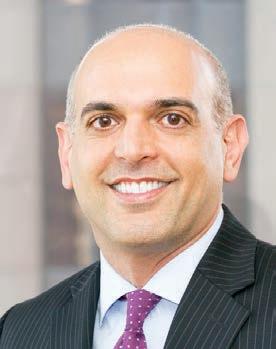

Given that Non-Loan Party Restricted Subsidiaries (i) do not have any obligation to repay the loan (either as a primary obligor or as a guarantor), and (ii) do not pledge any collateral to secure the loan, one might expect that the earning power of such Non-Loan Party Restricted Subsidiaries would be excluded for purposes of calculating EBITDA under the loan agreement. But the opposite, in most cases, is in fact the case (that is, the earning power of such Non-Loan Party Restricted Subsidiaries is included in the EBITDA calculation).
The reasons for this are primarily historical. Over time, the lending market has accepted the contention that the cash flow generated by the company’s entire ‘restricted’ business enterprise (that is, entities in the company’s corporate family that are subject to the terms of the loan agreement) should be considered as the basis for repayment of the debt.
But this approach has an apparent potential to impair
DAVID EBROON J.P. Morgan
JARED ZAJAC
Cadwalader, Wickersham & Taft LLP
lenders if a company group’s aggregate EBITDA is skewed towards Non-Loan Party Restricted Subsidiaries.
Consider the following:
Sample Facts
The lender has determined, based on the company’s static debt position, that the company must generate not less than $95 million of EBITDA in order to comfortably satisfy its obligations under the loan agreement.
As such, the lender establishes a covenant requiring that the company’s consolidated EBITDA not fall below $100 million.
Scenario 1
Loan Parties collectively generate $95 million of EBITDA.
Non-Loan Party Restricted Subsidiaries collectively generate $6 million of EBITDA.
Based on customary loan terms, the EBITDA of both the Loan Parties and the Non-Loan Party Restricted Subsidiaries are assessed for purposes of the EBITDA covenant -- meaning that $101 million of EBITDA is ‘counted’ for covenant purposes (and, as such, there is no default under the credit agreement).
Is the lender at risk?
As in Scenario 1, the EBITDA of both the Loan Parties and the Non-Loan Party Restricted Subsidiaries are assessed for purposes of the EBITDA covenant -- meaning that $101 million of EBITDA is counted for covenant purposes (and, again, there is no default under the credit agreement).
Is the lender at risk?
Yes, because the lender has access to only $6 million of the Loan Parties’ EBITDA cash generation and underlying pledged collateral to support repayment of the loan. Remember, the EBITDA of the NonLoan Party Restricted Subsidiaries counts for covenant purposes, but such Non-Loan Party Restricted Subsidiaries have no obligation to repay the loan (and have not pledged any collateral to secure the loan).
In both Scenario 1 and Scenario 2 above, an identical $101 million of EBITDA is generated by the company’s corporate family – but, in a downside scenario, the results for the lender would be dramatically different. Accordingly, lenders would be wellserved to consider the role Non-Loan Party Restricted Subsidiaries play in the company’s operations and revenue/ profit generation.

Given that Non-Loan Party Restricted Subsidiaries (i) do not have any obligation to repay the loan (either as a primary obligor or as a guarantor), and (ii) do not pledge any collateral to secure the loan, one might expect that the earning power of such NonLoan Party Restricted Subsidiaries would be excluded for purposes of calculating EBITDA under the loan agreement.
No, because the Loan Parties are primary obligors (or guarantors) of the loan (and have pledged collateral to secure the loan). As such, $95 million of EBITDA cash generation (sometimes referred to as ‘creditworthiness’) and underlying pledged collateral are available to the lender to support repayment of the loan.
Scenario 2
Loan Parties collectively generate $6 million of EBITDA. Non-Loan Party Restricted Subsidiaries collectively generate $95 million of EBITDA.
The straightforward antidote to the risk identified above is to limit (cap) the EBITDA generated by NonLoan Party Restricted Subsidiaries that count for purposes of calculating consolidated EBITDA for covenant (and other) purposes under the loan agreement. Unfortunately, the market has largely rebuffed this measure. Lenders may consider an alternative, more nuanced (albeit less effective) approach by adding additional covenants and/or incorporating more restrictions on high-EBITDA generating Non-Loan Party Restricted Subsidiaries.
Separate from the considerations set forth above, borrowers often negotiate the ability to invest assets among its corporate family – which right is typically subject to compliance with a pro forma leverage ratio. As Non-Loan Party Restricted
Subsidiaries customarily contribute to EBITDA, an investment of assets among Loan Parties and Non-Loan Party Restricted Subsidiaries is a leverage neutral event. As such, setting this leverage ratio too high could allow a borrower to remove assets from its lender’s collateral pool – by taking assets from Loan Parties and ‘investing’ them in Non-Loan Party Restricted Subsidiaries -- during a time of distress.
The threats posed by Non-Loan Party Restricted Subsidiaries are more subtle than those posed by Unrestricted Subsidiaries, but, in many cases, they are equally as serious. Most of these risks, however, can be mitigated by a thoughtful understanding of how Non-Loan Party Restricted Subsidiaries operate in the loan agreement context, and appropriately addressing these risks when underwriting loans and drafting loan agreements.
David Ebroon is an assistant general counsel at J.P. Morgan, serving on the commercial and investment banking legal team. He is the head of legal for midcorporate banking as well as capital & advisory solutions.
Jared Zajac is a partner in the leveraged finance group at Cadwalader, Wickersham & Taft LLP.

As Non-Loan Party Restricted Subsidiaries customarily contribute to EBITDA, an investment of assets among Loan Parties and Non-Loan Party Restricted Subsidiaries is a leverage neutral event.
The opinions expressed are those of the authors and do not necessarily reflect the views of their employer, their clients or any of their affiliates. This article is for general information purposes and is not intended to be and should not be taken as legal advice.
Supply Chain Finance in Turbulent Times: A Roundtable Discussion
BY EILEEN WUBBE

Members of SFNet’s Supply Chain Finance Committee, including Bryan Ballowe, managing partner, TradeCap Partners; Tony Brown, principal, The Trade Advisory; Alan Eliasof, CEO, Prestige Capital; Bob Grbic, founder and president, Bearbrook Corporate Advisors LLC and Megan Slovak, SVP, underwriting manager, Rosenthal Capital Group, sat down for a discussion about global trade tensions, tariff wars, factoring innovation, and supply chain risk.
This discussion was written in anticipation of SFNet’s upcoming Supply Chain Finance Conference which will be held September 8 at Greenberg Traurig in New York City. The event will offer a more in-depth look at supply chain finance. For more information and to register, please click here.
TSL: How are shifting geopolitical alliances and trade tensions impacting global supply chain financing strategies?
Tony Brown: I’ve been in the international trade business for about 50 years, and I don’t think I’ve ever seen a time more tumultuous or chaotic for people in cross-border trade than right now. There’s been a shift away from China, and sourcing has moved to Southeast Asia and Latin America. We’ve seen nearshoring and friendshoring, requiring supply chain finance programs to adapt to a more fragmented and diversified supplier base.
With that—and the tariffs, which are chaotic and range from 145% for China down to 10% for others, with rates anywhere in between—the dust is still not settled. One thing is certain. There is going to be cheating. People are going to transship; Chinese goods will go to Vietnam and appear to be Vietnamese, but they’re actually Chinese. There will be a lot of tariff engineering, where people are going to design products to fit a certain tariff category. This is going to cause the need for an immense amount of due diligence for compliance. If you are lending against inventory that’s supposed to be in one tariff category and it turns out to be another, or if goods are impounded by customs on arrival, that’s a serious problem.
We’ve also had currency and interest rate volatility. If tariffs are inflationary, which they are expected to be, interest rates will remain high. High interest rates aren’t good for business -- they weaken the economy. That’s likely to give rise to stagflation or a credit crunch, resulting in higher bankruptcies.
The dollar has weakened and if the U.S. dollar drops, foreign currency imports become more expensive, and if tariff rates are high, then that is likely to be inflationary.
Given this backdrop, there is an inevitable impact on supply chain finance. There is a lot of reshaping going on regarding factoring, supply chain disruptions, inconsistent delivery, and fulfillment issues are likely to increase accounts receivable volatility. As banks pull back from balance sheet lending, I think factoring, including reverse factoring, is likely to be a winner, especially for small- and medium-sized companies. Receivables financing will be an effective tool to manage cashflow volatility. Asset-based lending will remain resilient as traditional cash-flow lending tightens in the economic scenario I just described.
Overall, the climate is volatile. Strategies for supply chain finance must become adaptive and risk-aware, with a need for supplier support, cash flow optimization, and compliance. It’s a complex situation.
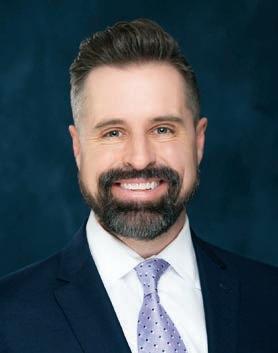




BRYAN BALLOWE TradeCap Partners
ALAN ELIASOF Prestige Capital
TONY BROWN The Trade Advisory
BOB GRBIC Bearbrook Corporate Advisors LLC
MEGAN SLOVAK Rosenthal Capital Group
Is factoring undergoing a reinvention in the digital era or is it being cannibalized by fintech alternatives and supply chain finance platforms?
Alan Eliasof: It’s being reinvented. Cannibalization, especially by the fintech and MCA (merchant cash advance) world, is happening more. MCAs are readily available with funds to our prospective clients. Factoring can close deals in 5-7 business days compared to a bank or asset-based lender that can take 30-60 days or longer. MCAs will close in 24–48 hours, so when a client needs funds that is their first and easiest method, even if the expense is much greater than a traditional method.
So, even though we are less expensive than MCAs we’ve had to reinvent ourselves by becoming more reactive and funding faster and changing our pricing model. For instance, while we did not charge minimums or closing fees and had slightly higher factoring rates, now we’ve changed to compete.
The fintech world is on every deal we see. As we look at prospective clients, where the AR is $2 million, and there is either a small bank loan or an SBA loan, or other small funds that we were able to augment or supplement the clients’ cash flow, now they have four MCAs, and sometimes the total exposure is greater than the availability that we have to do a deal.
Eliasof: The tariff war has hurt factoring not so much in recourse vs. non-recourse, but it paused some clients’ deals. We had a client with a $1.5 million order with a large retailer, importing the goods from China. When the tariffs increased dramatically, the deal was no longer profitable. The client paused the entire order, even after getting price concessions from the retailer, just not enough to be profitable. We’ve lost prospects who will no longer be needing factoring for the potential future because tariffs hit them so hard.
Tariffs didn’t cause much of a shift in the recourse/nonrecourse world; that happened five years ago when COVID hit. Before COVID, most of our deals were non-recourse. When COVID hit we had to go back to all of our existing clients and any new and say any non-recourse deal had to immediately change to recourse. Almost all of our new deals now are on full recourse to the client. Large retailers’ bank and self-funded programs also hurt us, taking away potential funding opportunities. We still close many new and existing deals, but advanced funds have shrunk due to reverse factoring.

While channel and dynamic financing is growing, in particular with investment-grade companies, it can currently take 10–20 days for invoices to be processed and posted to these platforms before they are eligible for discounting. Factors, on the other hand, have the option to lend on the assignment of an invoice which can afford a liquidity-strained borrower funds in a shorter time frame.
Reverse financing or supply chain finance are also causing us problems. A prospective client might be working with one of the large retailers offering a program that is quick, reasonable, and, in many cases, cheaper than factoring. So, they take that program and it reduces the availability of funds under our formula of what we can advance. It means we now make a smaller deal with that client, or sometimes we don’t even get the client, because the amount available after this reverse factoring doesn’t give us any available funds.
How are buyers’ payment behaviors evolving during the tariff war and what implications does this have for recourse vs. nonrecourse factoring structures?
Brown: On the digital side, there’s a beneficial effect from digitization in factoring. There’s been uptake in AI—which can help, for example, in verification processes using natural speech to interface with accounts payable departments. That’s a big benefit for what is traditionally a laborintensive and expensive process.
Procurement platforms are also now embedding a factoring option. When Procurement issues a purchase order and the seller invoices, there’s often an immediate option for the supplier to obtain payment within the platform itself. That is likely to have an impact on factoring volumes.
Eliasof: I agree, Tony. The verification side can certainly be expedited by AI. At the same time, we are still old-fashioned where we like the personal touch and relationship that is involved
with somebody in payables in a warehouse. So, AI is expediting but can be a hindrance in some ways. It is sometimes hard to differentiate a fraudster using AI from the real potential debtor that we’re trying to reach. We’re still doing a lot of confirmation by phone.
Bob Grbic: While channel and dynamic financing is growing, in particular with investment-grade companies, it can currently take 10–20 days for invoices to be processed and posted to these platforms before they are eligible for discounting. Factors, on the other hand, have the option to lend on the assignment of an invoice which can afford a liquidity-strained borrower funds in a shorter time frame.
You may also have the option, depending on the platform, to structure deals where you can finance borrowers’ receivables that can eventually be discounted through a Supply Chain Financing Platform, which may appeal to some borrowers while still affording a factor a financing role, albeit for a short duration. If the factor also provides inventory financing, they will have a veto on whether a borrower can discount the receivable arising out of financed inventory with a third party. AI’s value to lenders and the supply chain is growing and is becoming increasingly more important in verifying the integrity of transactions. However, we should never discount the importance of understanding the relationships and interdependencies among all the players in the supply chain cycle.
and opting to shift factories from one country to another to avoid the higher tariffs, creating significant challenges that pose the questions: Is the factory capable of producing the product I need, on time, with the right quality? What are the payment terms? The new factory may not allow open terms or provide credit requiring a guarantee or letter of credit. During these times companies are reaching out to inventory and purchase order finance lenders for support.
In-transit inventory and purchase order financing funding methods include letters of credit, cash against documents, or collection payments and PO finance lenders and ABLs can provide these programs. Lenders must be prudent when making payments to overseas vendors and should always vet new factories and require an inspection preshipment.

In-transit inventory and purchase order financing funding methods include letters of credit, cash against documents, or collection payments and PO finance lenders and ABLs can provide these programs.
Has there been an increase in risk to inventory finance during the tariff war? If so, what are those risks and how has inventory finance addressed those risks?
Megan Slovak: Absolutely, for many of the same reasons Tony, Alan, and Bob discussed. Higher tariffs lead to higher costs of goods sold which ties up capital in inventory costs. Combine that with longer lead times, transit times, potential customs holds, and any other unforeseeable supply chain issues and risk increases. The tariff war has created uneasiness among suppliers and buyers. Buyers are trying to find the best rates
Another risk is companies may not realize that factories are shifting shipping terms. Factories may move from FOB (buyer is importer of record) to a DDP model (supplier is importer of record), sometimes requesting prepayments or deposits. If goods reach the US but aren’t cleared, when the supplier was responsible for clearing customs, buyers could face added costs, eating into profit margins and inventory values. As a lender or a borrower, it is crucial to understand shipment terms.
Customer cancellations are also a risk for inventory lenders, especially purchase order finance lenders. The whole transaction for a PO finance lender is based on the customer and the strength of that customer order.
Brown: The tendency to want to pass the whole responsibility to the foreign supplier to make the goods, ship them, clear customs, pay the duty and deliver the goods as if they were a domestic vendor all sounds good, except it’s fraught with risk. The supplier may not be honest about tariffs and product classification requirements. They are the importer of record, so they have to comply with the Customs Modernization and Informed Compliance Act (Mod) and maintain that information, and if there is an issue, they are responsible. The Trump Administration is looking to stop foreign suppliers being the importer of record and that could really put a wrench in the works for that structure.
Many suppliers in developing countries have greater challenges with access to capital and cost of capital and if you’re asking them to use limited access to finance to make, ship, hold the goods, and pay the duty, they may be able to do that, but at what cost?
Based on the current environment (both macro and geopolitical), has there been a stronger need for inventory finance and procurement to partner with other forms of supply chain finance including receivables finance and reverse factoring?
Ballowe: The current uncertainty and risk in the market provides an excellent opportunity for the non-bank lenders to step up and provide significant benefit and value to borrowers from a risk-mitigated perspective. In order to do so, lenders must get deep into the weeds and understand clients’ business models as well as supplier and customer relationships. Everyone in the supply chain is trying to mitigate risk right now. All this uncertainty brings the need for more understanding, transparency, and structure.
Lenders need to determine whether their borrowers can source goods effectively. Are terms with overseas suppliers changing whereby borrowers are having to catch up on supplier payables while pre-paying to have additional product produced and shipped? Is cash flow starting to deteriorate as a direct result of the quickly changing dynamic with existing suppliers? Are borrowers sitting on a lot of inventory that they brought in ahead of the tariff announcement in order to mitigate the tariff risk, but demand has now significantly decreased?
suppliers (FOB, CIF, or Delivered Duty Paid), you can find yourself on the wrong side of tariff negotiations and end up losing money by the time goods clear U.S. customs.
Brown: Creditworthiness will suffer. I believe that there will be more stress in company financials, more bankruptcies, and possible pullbacks on lending limits and advance rates. To me this environment is pretty toxic.
Slovak: When PO finance lenders are asked to open letters of credit months in advance, relying on future orders, it increases risks. Extended timelines bring risks that orders could be canceled or deferred before goods are ready to ship.

The tendency to want to pass the whole responsibility to the foreign supplier to make the goods, ship them, clear customs, pay the duty and deliver the goods as if they were a domestic vendor all sounds good, except it’s fraught with risk.
Another risk that Megan alluded to is the time aspect of this uncertainty related to the fluctuations in tariffs. For instance, if you’re on the procurement side, and you’ve got 90 to 120 days lead time to get goods produced and delivered from your overseas suppliers, you really don’t know what your cost of goods is going to be. When you have extended exposure to overseas suppliers alongside the current uncertainty with tariff fluctuations, depending on how you’re buying from your overseas
With global supply chain disruptions becoming the norm, how should lenders and insurers reassess supplier default and geopolitical risk? What are the implications for assessing counterparty risk on a secured/ unsecured basis?
Grbic: It starts with reunderwriting the deal. Everything you thought about credit or past trends — throw out the window. It starts with understanding how your borrower’s business model has changed post “Liberation Day” and with the expectations of higher and erratic tariffs on imports, you need to consider that every player in your borrower’s supply chain is engaged in “price discovery” to remain competitive. Every supplier to the end customers in the chain is looking to obtain lower prices and better terms to help absorb the impact of higher tariff-related costs.
How important is your borrower to its customers and suppliers? If your borrower is selling generic products, their customers have more options to find alternative suppliers at lower prices than if they are selling unique branded or patented products. The worst-case scenario is that your borrower loses a customer to a competitor because of tariff-related issues while still having related inventory commitments. On a positive note, resourceful and better-financed borrowers may be able to displace competitors.
Another important issue that needs to be considered, in addition to costs, is credit terms from new suppliers entering the borrower’s supply chain. Long-established relationships often benefit from the seller granting favorable terms to the buyer. The extension of favorable credit terms has helped fuel China’s growth and afforded companies the benefit of financing inventories through payables. With new suppliers, from smaller export countries entering the supply chain mix, we need to assume that borrowers will face a contraction of open payable support and need to rely more on lenders to finance imports. The worst case, cash deposits (not recommended) or documentary Letter of Credit, might be required by the suppliers and /or by the country of export regulations.
Another concern — what due diligence has the borrower performed on the reliability of a new supplier in terms of delivering quality products on a timely basis? Does this supplier have “credit” to secure the components needed and pay for the related labor? This risk is greater for smaller importers that don’t have standing to secure production from more well capitalized foreign suppliers that are often larger, better financed U.S companies that can afford to give the supplier larger production commitments.
Brown: Reshoring is widely discussed, but for highly laborintensive products the U.S. will not be competitive; we will still be import-dependent but diversified sourcing will accelerate. The tariff issue today is just one passing phase. Hopefully, it will end really fast, but it will end. We’ve had supply chain disruptions of all flavors – logistics snafus, wars, pandemics. Global trade is going to continue.
Grbic: There’s nothing better than boots on the ground and backing a strong management team. The companies that strive and can pick up market shares as weaker companies fall are those that are well managed. Successful importers frequently visit their offshore suppliers and/or have country on-site staff to monitor their suppliers’ order flow. We need to remember market challenges also breed opportunities.
Eliasof: For factoring, gross margin has never been as important as it is now. We were always collateral based. As long as the receivables were good receivables, verifiable, with a good, strong, creditworthy customer, we didn’t care as much about the gross margins. We’re now asking what their margins are upfront. Time is now the enemy. If the order gets delayed, postponed, or takes longer to get there, the costs are going up dramatically for our client.
Ballowe: Supplier and customer diversification is also essential and raises its head as we enter into trade or tariff wars where it creates supply chain disruption. It’s easy when you buy one or two products from just one supplier. You know each other and what your payment terms are. But as soon as disruption hits, lack
of supplier diversification impacts your entire business. Shifting to a new supplier introduces new risks and challenges including payment negotiations, sourcing challenges, and quality issues.
Slovak: It is important to encourage clients, especially importers, to maintain a strong relationship and keep in constant communication with their logistics parties (warehouses and freight forwarders) because that’s crucial with tariffs and trade wars. This helps navigate shipping and customs challenges, and helps lenders monitor inventory and payables.
If you could change one thing in the global supply chain finance ecosystem in the next 12 months, what would it be — and why?
Brown: The supply chain finance ecosystem suffers from fragmentation and lack of harmonization. Buyers, suppliers, lenders, insurers, technology platforms all operate in silos, and this hinders transparency, delays transactions, increases the cost of capital and restricts access to finance. So, my big wish is that there should be greater use of digital data across supply chains, and more integration of that data to inform people who are managing transactions in trade, logistics and finance, so that there’s interoperability and standardization to unlock greater potential for supply chain finance.
Eliasof: I would love to see AI or technology adding better communication between all those parties involved in the supply chain, whether it is between a factor and getting better information from the account debtors on verification or between the purchase order to the purchase order finance company.
Ballowe: Eliminating uncertainty in the supply chain ecosystem in which we play and as well as solidifying what the clear rules of the game are for all players. If the supply chain ecosystem is stable, we can all adapt and maximize profitability and begin to operate efficiently. Standardization and digital data digitization will certainly help remove uncertainty.
Slovak: Greater consistency would benefit all of us. The fluid macroeconomic environment, particularly evolving regulatory and tariff regimes, makes it challenging for borrowers to build a realistic cash-flow forecast.
Grbic: Barring a national crisis, such as an armed conflict, I would like to see a global rule set giving a defined notice period before tariffs are imposed to give importers/exports time to react and explore options. Giving production cycles for some industries - 9 months would be a place to start.
Eileen Wubbe is senior editor of The Secured Lender magazine.
THE ANATOMY OF A DEAL
Breaking the MCA Cycle and Rebuilding a Brand
BY DARREN PALESTINE
Not all deals begin with pristine financials and optimal timing. Some of the most meaningful transactions—the ones that genuinely shift the trajectory of a business—are born from tough circumstances. This was one of those.
We were introduced to a women’s apparel brand—well known in the retail world for its intimate apparel accessories—shortly after the company had transitioned from a factoring facility to an asset-based lending (ABL) relationship. The new ABL line unlocked availability on receivables and inventory that the company had never had before. It was a major step forward, but unfortunately, it didn’t solve the biggest problem.
Like many companies navigating uncertain economic waters, this business had turned to merchant cash advances (MCAs) to keep moving. But they didn’t just take one or two advances— they stacked several, using the funds, under poor advice, to invest in domestic equipment purchases and expand manufacturing in the U.S. The intent was good: build in America, own their supply chain, improve margins. But the timing was off—this happened long before tariffs and reshoring incentives became part of the national conversation. What they were left with was heavy MCA debt and no clear path to get out.
Even with the new ABL line in place, they were buried under debt.
To their credit, the ABL lender saw both the potential and the problem. They had taken a UCC assignment and understood the layered complexity of the MCA positions. But they also knew the business couldn’t scale—or even operate sustainably— without addressing the elephant in the room. That’s when they brought us in.
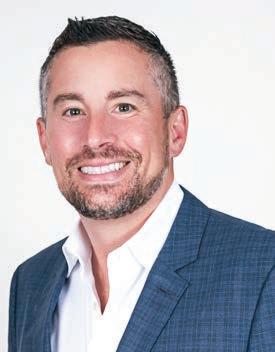
DARREN PALESTINE
Commercial Finance Partners
At Commercial Finance Partners, we’re often called when the path forward isn’t straightforward. Our job is to make the messy situations manageable. This one had a lot of moving parts, but it was clear from the beginning that success meant more than simply refinancing existing obligations. It meant fixing the structure entirely—rebuilding the company’s capital foundation from the ground up.

The intent was good: build in America, own their supply chain, improve margins. But the timing was off—this happened long before tariffs and reshoring incentives became part of the national conversation. What they were left with was heavy MCA debt and no clear path to get out.
Anyone who has worked in the space knows the MCA cycle is a trap. The daily and weekly repayments quickly cannibalize cash flow. In this case, the company’s total monthly debt service had climbed to over $750,000. That kind of pressure impacts everything—operations, morale, vendor relationships.
We got to work immediately on two fronts. First, we helped keep the company operational during underwriting, ensuring cash flow remained steady enough to meet payroll and critical vendor obligations. Second, we started mapping out a long-term capital solution—one that would eliminate the MCA burden and properly size the working capital to match the company’s real needs.
This wasn’t just about finding a lender. It was about understanding the operational dynamics: production cycles, inventory turns, customer payment behavior. We worked closely with the leadership team to assess where the business stood—
and where it could go—if given a fresh start.
After weeks of work, we were able to facilitate a $5 million term loan, stretched over 10 years. This was the gamechanger. The long amortization brought the company’s monthly debt service down from over $750,000 to just $67,500. That reduction didn’t just improve liquidity—it gave the business room to breathe.
And that breathing room has made all the difference. Today, the company is fully manufacturing in the United States. The equipment they financed years ago is finally delivering value. The MCA lenders are gone. The capital structure makes sense. The ABL continues to support day-to-day operations, and the long-term debt is manageable. Most importantly, the company is no longer making decisions based on cash flow desperation. They’re making strategic choices based on growth.
We don’t always talk about the emotional toll in this line of work—but it’s real. When owners are under that much financial pressure, it shows up in every aspect of the business. There’s no time to think about strategy when you’re worried about making next week’s payments. In this case, we weren’t just helping a brand—we were helping a group of people get their company, and their future, back on track.
Every deal has its challenges, and this one certainly had more than its share. But these are the projects that stick with us. Because they remind us what finance can do when it’s done right. Not just fund a business—but save one.
structured term loans. In addition to financing, we support clients with debt advisory services, financial planning, and business insurance to help improve liquidity, manage risk, and support growth.
Darren Palestine is managing partner at Commercial Finance Partners, a nationally recognized debt advisory and direct lending firm. He oversees new business origination, helping businesses access creative financing solutions. Darren has structured over $1 billion in financing across asset-based, term loans, and specialty lending products. He is known for his strategic approach, industry expertise, and commitment to client success.

The equipment they financed years ago is finally delivering value. The MCA lenders are gone. The capital structure makes sense. The ABL continues to support day-to-day operations, and the long-term debt is manageable.
About Commercial Finance Partners
Commercial Finance Partners provides funding solutions for small to middle market companies that are seeking non-bank sources of capital. Through direct lending and a broad network of financing partners, we deliver a wide range of options including accounts receivable financing, asset-based loans, equipment and real estate financing, cash flow lending, and creative
THE ANATOMY OF A DEAL
Tequila Komos: Scaling a Luxury Spirits Brand Through Strategic Financing
BY LAUREN ADELSON
Master Sommelier Richard Betts founded Tequila Komos in 2019 with the goal to position tequila alongside the world’s finest aged spirits. Within a few years, his idea to merge French winemaking techniques and traditional Mexican distillation propelled Komos to become one of the fastestgrowing premium tequila brands in the U.S.
By 2021 Komos was a category-leader in boutique hospitality and was quickly gaining traction with luxury accounts. With strong distribution in hospitality already in place, national retail presented a major expansion opportunity. Maintaining their existing distribution network, solidifying their positioning in the luxury market and entering national retail would require them to massively ramp up inventory production. Like many scaling beverage businesses, Komos sought a working-capital partner to help cover rising production costs without eating into equity dollars.
After evaluating their options, Komos partnered with asset-based lender Dwight Funding. Dwight’s team brought unparalleled experience in the spirits industry and a flexible credit solution specifically designed to support the acute needs of growth-stage businesses like Komos. Over the course of the relationship, Dwight’s revolving line of credit helped support Komos’ continued growth in luxury hospitality, award-winning SKU launches, and national retail expansion into over 20 states.
This case study outlines how the right financing solution helped a high-growth spirits brand overcome capital constraints and achieve outsized results in a capital-intensive industry.
Brand Origins and Luxury Positioning
Komos was founded with the goal of redefining what tequila could represent on the global spirits stage. From the outset, Betts set out to position it alongside aged whiskeys and fine cognacs, spirits known not just for craftsmanship, but for their cultural status and high margins.
To deliver on his vision, Komos differentiated itself through:
An unconventional aging process using French oak white wine barrels, producing a layered, nuanced profile
uncommon in tequila. Design-forward packaging, with ceramic bottles inspired by GrecoRoman amphorae that quickly became a visual hallmark in the category.
Strategic trade placement in highend hospitality and Michelin-starred restaurants, building early credibility with influential partners.

LAUREN ADELSON
Dwight Funding
Realizing this vision required more than operational capital. Premium tequila demands long production cycles, custom packaging, and consistent availability across prestige accounts. Inventory must be produced well in advance, aged, and stocked at levels that support growth across the three-tier system. The resulting cash cycle is long and uneven, further compounded by distributor payment terms of 30 to 60 days. The brand needed a capital structure designed specifically for these unique industry dynamics given the pace of Komos’ growth trajectory.
Dwight Funding’s Tailored Financing Approach
With 15+ years of experience supporting scaling beverage brands and a clear understanding of Komos’ expansion plans, Dwight structured a flexible line of credit backed by the brand’s landed inventory and receivables. This financing solution supported both immediate growth needs and long-term strategic initiatives:
1. Production Scale & Inventory Build
As Komos expanded from boutique hospitality placements to national retail distribution, inventory requirements shifted dramatically. The brand needed to ramp up bottle production and maintain significantly higher stock levels, which improved cost efficiency and helped maintain strong in-stock rates across their growing national footprint.
2. Distributor Concentration Underwriting
Dwight’s experience in the spirits category informed a thoughtful approach to Komos’ concentrated distributor base. While this model may raise concerns for lenders without category familiarity, Dwight recognized it as a standard and essential element of growth in the industry. This specialization allowed for increased availability within the facility that aligned with their ambitious expansion plans.
3. Strategic Product Launches
The facility supported bulk production of premium SKUs and limited editions, including the Añejo Reserva, by providing working capital for specialized production runs and premium packaging. These releases reinforced the brand’s luxury positioning and created new opportunities with influential trade and retail partners.
4. Overadvance for Production Continuity
Dwight provided an initial overadvance (additional capital outside of the loan amount) to ensure Komos could fulfill existing distributor commitments while simultaneously funding expansion into new markets. This prevented the brand from stocking out on current orders as they scaled operations.
Partnership Impact & Outcomes
The financing partnership produced clear and measurable results across several areas of the business:
National Expansion: Komos entered more than 20 new markets within a year of securing the facility, evolving from a regional player into a nationally recognized luxury brand.
Prestige
Account
Growth: New placements in elite hospitality venues, including Michelinstarred restaurants and Soho House, helped reinforce the brand’s position in the luxury market and drove increased velocity.
Product Innovation:
A flexible capital structure allowed Komos to launch premium SKUs and limited editions that created new revenue opportunities and earned them
financing can unlock growth in the spirits industry. Scale often depends on more than strong sales and brand momentum. It requires financial partners who understand the operational realities behind each growth milestone and can design a solution that supports both day-to-day execution and long-term strategy.
Key Takeaways
1. Choose a Lender Who Understands Your Industry and Growth Plan
Effective financing starts with alignment. A lender with spirits category experience can structure a credit facility that reflects how your business operates and gives you the flexibility needed to truly support outsized growth rather than just maintain operations. This specialized knowledge also means they can step up during unexpected cash gaps that they recognize as standard working capital cycles in this category.
2. Flexibility Supports Strategic Growth
Strategic opportunities rarely follow a fixed timeline. Brands need access to capital that adapts to their growth pace, whether they’re investing in new SKUs, deepening distributor relationships, or entering new markets. Flexibility within a credit facility can be the difference between momentum and missed opportunity.

The Komos story offers a clear example of how thoughtful financing can unlock growth in the spirits industry. Scale often depends on more than strong sales and brand momentum.
recognition as The Tasting Panel Magazine’s highest-rated tequila collection in history.
Operational Stability: With capital in place to support both production and expansion, the team was able to focus on strategic growth rather than near-term financing gaps.
Lessons for Scaling Spirits Brands
The Komos story offers a clear example of how thoughtful
As director of marketing, Lauren Adelson leads Dwight Funding’s marketing efforts, overseeing brand strategy, content development, and external communications to strengthen the firm’s position as the leading working capital partner for scaling consumer brands. Prior to joining Dwight, she worked in experiential marketing and strategic partnerships at The Sharpe Alliance, a boutique agency based in Los Angeles. Lauren holds a B.S. in Marketing and Business Management from the A.B. Freeman School of Business at Tulane University.
THE
ANATOMY OF A DEAL
How Flexible Financing Fueled Rapid Growth for a Fast-Moving Food Brand
BY SUE DUCKETT
When Duke Pham and his fast-growing food company Pho’nomenal Foods needed capital to meet surging demand, traditional lenders weren’t an option. That’s where Franklin Capital stepped in—helping turn potential roadblocks into a springboard for rapid national expansion.
Where it All Started
Duke Pham’s journey began as an infant when his family fled Vietnam in 1975 during the fall of Saigon, seeking safety and a new life in the U.S. as refugees. Despite the odds, Duke carved out his version of the American Dream—founding and operating six acclaimed Pho restaurants in the Seattle area under the name What the Pho? These restaurants laid the foundation for his next venture: Pho’nomenal Foods.
Duke launched his consumer-packaged-goods company, Pho’nomenal Foods, in 2016—their flagship product— pho, instant noodles with a unique twist—first hit shelves through Costco. While the opportunity was exciting, it quickly presented a new challenge as demand outpaced cash flow.
Their Growth Story
“We were growing faster than I could get funding for, especially with traditional banking,” Pham explains. “They don’t touch young companies.”
Fortunately, he was no stranger to alternative financing. Having used factoring with a previous software company, he was able to connect with Franklin Capital in 2021 to utilize their accounts relievable and purchase order financing. What began as a practical financing solution quickly evolved into a long-term partnership.
With products moving in Costco, Sam’s Club, and major retailers like Target, Kroger, Safeway, Albertsons, and Publix, the company has needed significant capital to fund million-dollar inventory runs. “Sam’s Club placed a $500,000 order at one point,” he says. “Franklin was able to fund that launch.”
The need for working capital has continued to grow since then. “We’ve launched a second product with Costco, and we’re now moving about $1 million a month in product. With Costco, we have a 90-day production cycle and need to have inventory ready to go in our warehouse before Costco even places their orders. That requires capital. It simply wouldn’t be possible without the funding Franklin provides. Their capital is what makes this growth achievable.”
Beyond financing product growth, the accounts receivable and purchase order funding has allowed the company to scale across all areas of the business. “We’ve built out a full marketing team, opened our own warehouse, and are investing in new product development,” he says. “The more we sell, the more we earn—and we’re reinvesting profits to keep the growth going.”
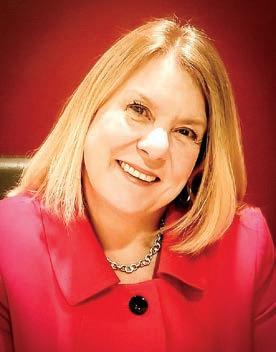
When asked about one of the biggest takeaways from working with Franklin, Pham mentioned, “They have allowed us to grow and continue to thrive as a company. Their team is amazing—flexible and responsive. They continue to be our bridge between startup and bankability.”
“Duke’s journey is exactly the kind of story we love to be part of,” said Sue Duckett, COO of Franklin Capital. “We see ourselves not just as lenders, but as long-term partners in our clients’ growth. It’s been a joy to support Duke through different stages of expansion—and to watch his vision evolve into something extraordinary. Our entire team is cheering him on.”
The Future Looks Bright for Pho’nomenal Foods
While the goal is eventually to secure traditional bank funding or private equity investment, Pham acknowledges that reaching that milestone wouldn’t be possible without the foundational support Franklin provided. “We’ve already had interest from private equity and even one of the major grocery chains who want to invest directly in our company.”
It hasn’t always been smooth sailing. “COVID nearly took us out. At one point, we couldn’t pay a storage bill, and the warehouse wouldn’t release our product. Franklin was always there when we needed help. Without them, we wouldn’t be here today.”
As the company looks ahead to a potential Series A round in the coming year, the founder is clear: “We owe a big part of our success to Franklin. They believed in us when others wouldn’t—and gave us the tools to thrive.”
For more than 25 years, Sue Duckett has worked with top commercial finance firms in both the U.S. and the U.K. Today, she’s the chief operating officer at Franklin Capital, where she runs operations and handles incoming deals—with a focus on factoring transactions. Sue is also a board member of the Secured Finance Network’s Midwest Chapter and an active member of the Turnaround Management Association.
SUE DUCKETT
THE ANATOMY OF A DEAL
How Deep Understanding Drives Smarter Capital Solutions
BY SCOTT WINICOUR
A successful financing transaction is about far more than numbers on a spreadsheet. While financial ratios and collateral coverage are essential, the real essence of a transaction lies in the creative collaboration, diligence, and partnership that transform complex business needs into growth opportunities. Our team at Gibraltar Business Capital (GBC) demonstrated this approach through our ongoing financing partnership with Prodigy Health.
Prodigy Health, a rapidly expanding specialty pharmaceutical distributor, initially approached us to support growth and expansion. Our initial $25MM asset-based line of credit provided a foundation for growth and expanded distribution capabilities. As Prodigy’s business model evolved—shifting focus toward higherturn products and new customer segments—the need for greater financial agility became apparent. Our team responded with subsequent increases in the company’s line of credit, ultimately reaching today’s line of credit facility of $35MM.
Collaboration Beyond the Template
prioritized understanding the company’s growth strategy and evolving product mix.
A key theme in our approach was the thorough diligence undertaken by our team, not only to understand Prodigy’s current business, but also the nuances of various business models and industry shifts. We thoroughly studied how Prodigy works with manufacturers to gain approval for selling new products and earning fee income, ensuring our structure would support both present needs and future opportunities.


Through open communication and a shared sense of urgency, we developed a creative solution to increase Prodigy’s line of credit to $30MM in 2024, with a subsequent increase to $35MM in 2025. In the interim, we made out-of-formula borrowing base accommodations to ensure Prodigy could continue purchasing inventory and supporting working capital needs until the formal approval of planned increases was complete.
At GBC, we believe every deal deserves its own blueprint. Our underwriters, drawing on backgrounds in investment banking, auditing, and hands-on deal-making, conducted deep diligence into Prodigy Health’s operations. This wasn’t a mechanical, one-size-fits-all exercise; it was a client-centric process that
Creative ProblemSolving in Action
Over the course of the relationship and business evolution, the team has expanded Prodigy’s line of credit multiple times to meet shifting needs. Our underwriting team balanced flexibility with prudent risk management, leveraging in-depth analysis to unlock more value in Prodigy’s collateral while ensuring the structure remained sound. We invested heavily in upfront diligence, maintaining senior-level involvement throughout the process to accelerate timelines and build confidence on all sides.
Like many growing businesses, Prodigy Health faced unforeseen challenges after initially closing the loan. Still, our team consistently demonstrated patience and flexibility, working closely with Prodigy as they navigated those challenges and mapped out a sustainable path forward. Through open communication and a shared sense of
SCOTT WINICOUR Gibraltar Business Capital
urgency, we developed a creative solution to increase Prodigy’s line of credit to $30MM in 2024, with a subsequent increase to $35MM in 2025. In the interim, we made out-of-formula borrowing base accommodations to ensure Prodigy could continue purchasing inventory and supporting working capital needs until the formal approval of planned increases was complete. This hands-on, adaptive approach allowed Prodigy to capitalize on new customer opportunities and navigate shifting market dynamics without being constrained by rigid lending templates.
Delivering Results and Building Trust
The true measure of success isn’t just closing a deal; it’s building a partnership that endures beyond the closing table. For Prodigy Health, our willingness to listen, adapt, and act quickly has translated into tangible business benefits: increased working capital, greater operational flexibility, and the confidence to pursue new growth opportunities. Our approach is rooted in creativity, diligence, and a client-first mentality, which continues to distinguish GBC. We don’t just provide capital; we deliver solutions that help businesses like Prodigy Health thrive in the face of change. As Prodigy continues to expand, GBC remains a steadfast partner, committed to supporting their journey with innovative, flexible financing that evolves in tandem with their needs.
is an expert financial partner providing lower midmarket companies nationwide access to capital when needed most to solve challenges or fuel growth at any stage of the business lifecycle. With over 70 years of experience, Gibraltar’s team is trained to listen, think critically, and consider unique circumstances. For more information, visit www.gibraltarbc.com.
About Scott Winicour

Our approach is rooted in creativity, diligence, and a client-first mentality, which continues to distinguish GBC. We don’t just provide capital; we deliver solutions that help businesses like Prodigy Health thrive in the face of change.
In the words of Prodigy’s leadership, “The Gibraltar team has continued to invest the time necessary with us to understand our new strategic approach. They fully understand the unique nuances of our business and the complexity of shifting product strategies.” This is the anatomy of a deal at Gibraltar Business Capital: partnership, creativity, and a relentless focus on client success, regardless of the challenges or opportunities that arise.
About Gibraltar Business Capital
Chicago-based Gibraltar Business Capital is a wellcapitalized specialty finance company that delivers working capital in the form of asset-based loans ranging from $10 million to $100 million. Gibraltar
As CEO of Gibraltar Business Capital (GBC), Scott focuses on the overall strategic direction of the company as well as the credit, underwriting, sales, and marketing aspects of the business. Scott founded GBC in April of 2010 when he led the management buyout of Gibraltar Financial Corporation (GFC), an asset-based lender established in Chicago in 1951. Scott began his finance career as an account executive in 1995 at GFC. Earning his way up from the ground floor— learning the sales, credit, operations, and underwriting processes. Scott took over the operations in 2005. As CEO of GBC, Scott oversees the credit committee and gets personally involved in each transaction. Under Scott’s leadership, the company has supported over 300 middle-market clients and grown assets under management by 300%.
THE ANATOMY OF A DEAL
A Tale of Two Families: Trust, Perseverance and Partnership
BY ALFRED HEDAYA
The Hedaya Capital Group outlines a recent entrepreneurial transaction.
Combining a personal passion with a business idea and then turning it into a successful, growing company is akin to capturing lightning in a bottle. But that is precisely what one entrepreneur did, with help from his family, industry colleagues, and The Hedaya Capital Group.
After college, the entrepreneur’s love of sports, particularly golf, had him spending every spare moment on the links. Inspiration struck there: he envisioned a high-performance apparel brand that combined athletic function with everyday style that could be worn for many engagements. Soon, he left his position at a top sports talent agency and returned to caddying, dedicating himself entirely to launching his dream and the brand.
Before long, his pharmaceutical sales representative cousin became the brand’s first investor while leading the sales function, going from doctors’ offices to golf shops. Later, his brother, a chef in New York City, tossed off his apron to help launch their New Jersey-based high-end golf apparel brand.
paid off. With products stocked in 2000+ country club shops, they began expanding to big box stores such as Bloomingdale’s, Macy’s, Saks Fifth Avenue, and DICK’S Sporting Goods, growing their footprint dramatically. Additionally, the Company was simultaneously building its online retail presence, which had taken off with the support of brand enthusiasts.
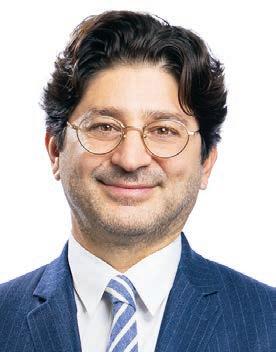
ALFRED HEDAYA Hedaya Capital Group
With booming wholesale sales comprising many varied accounts, managing accounts receivable had become cumbersome and time-consuming. The Company turned to its business advisor to navigate that growth. He immediately recommended Hedaya Capital, knowing the firm’s deep industry expertise, family values, and high-touch approach would be a perfect fit.

As the Company continues its rapid rise, Hedaya Capital remains a key partner, evolving its support to match the Company’s needs. The next phase of the relationship includes a significant inventory-based line of credit, something few traditional lenders could offer.
The trio crisscrossed the country, visiting country clubs to bootstrap a fashionforward brand that would honor their core commitment to sports and high-level performance, and design unparalleled ultra-comfortable products. Beginning with golf shirts, they have expanded their product line to include knits, shorts, pants, outerwear, and accessories. Their grit and perseverance
From the start, Hedaya Capital saw the Company’s potential, and upon meeting the founders, they felt immediately invested. Hedaya Capital is known for its consultative partnership approach and desire to help clients grow and protect their businesses. Initially engaged to manage accounts receivable and collections in a challenging environment, Hedaya soon began helping with funding.
When Hedaya Capital came on board, there was a sense of urgency. The Company was outgrowing its credit lines and needed support to manage larger sales volumes and more complex operations.
The founders had been relying on credit terms from a factory supplier but were nearing their limits. In addition, their local
bank could not be flexible enough to increase their modest line of credit to scale along with the Company’s needs. The online business had grown to become close to 50 percent of the Company’s sales, which is difficult to finance with traditional lenders. The Company needed more dynamic financing to match its momentum and evolving business strategy.
At the same time, the founders began working with a data analytics firm that offered daily, real-time insights into inventory movement, media spend, return on advertising spend, and financial performance for its direct-to-consumer online business. That robust data and visibility gave the Company insight to improve their business plan and gave Hedaya Capital confidence to give them higher leverage on collateral, particularly inventory.
Hedaya Capital initially provided a $2.5 million factoring facility that enabled the Company to continue to expand, fueling investment in production, operations, staff, and design. It also provided consistent cash flow that enabled the Company to pay suppliers on time, resulting in better credit terms and pricing. What’s more, Hedaya’s flexible approach allowed the Company to start gradually factoring its receivables, beginning with its big-box customers while slowly integrating its country club customers to ensure they had the proper process in place.
“Hedaya Capital helped us find a better process to keep our accounts receivable at a respectable and appropriate amount as growth exploded,” said the Company’s CFO. “They have been great in understanding where we are in our growth cycle, helping us collect outstanding receivables and provide flexible financing without bank restrictions. They made the transition smoothly and gave us the capital we needed to grow while alleviating stress at the same time.”
As the Company continues its rapid rise, Hedaya Capital remains a key partner, evolving its support to match the Company’s needs. The next phase of the relationship includes a significant inventory-based line of credit, something few traditional lenders could offer. The transaction consists of a $7.5 million total credit line with a sublimit of $3.5 million for inventory advances designed to help support the Company’s growing wholesale and direct-to-consumer inventory needs. Hedaya Capital saw where the founders were in their journey— nearing an equity capital raise but needing substantial working capital—and knew how to shepherd them forward. Their data gave Hedaya Capital fantastic insight and in turn, Hedaya Capital was able to offer an extraordinarily high amount of support against their accounts receivable and inventory assets to enable them to continue growing.
Prior to receiving financing from Hedaya Capital, the Company’s sales were $13 million, climbing to $20 million within a year. Sales for 2025 are expected to double to $40 million with the increased inventory financing.
The partnership between Hedaya Capital and the Company illustrates the power of shared values, strategic finance, and entrepreneurial perseverance. Together, they are proving that
with the right team, even a dream born on a golf course can scale into a nationwide success.
Alfred Hedaya is a founding partner and principal of The Hedaya Capital Group, responsible for the firm’s overall leadership and strategic vision. Over the last 20 years, he has earned a reputation for his ability to quickly underwrite traditional and non-traditional financing structures to support clients’ growth needs across a wide range of industries. He understands how trade finance tools, including factoring, assetbased lending, letters of credit, and purchase order financing, can propel small businesses and middle market companies forward. He is passionate about the firm’s collaborative approach and commitment to fair dealings based on honesty and integrity. Prior to co-founding The Hedaya Capital Group, Alfred held senior leadership roles in merchandising and sales in the consumer products and apparel industries, giving him valuable insight into the financing needs of entrepreneurs and management teams.
THE ANATOMY OF A DEAL
Baking Company Rises by Finding the Right Lending Partner, JPalmer Collective
BY JENNIFER PALMER
When a fast-growing, women-owned baking company was on the brink of collapse, JPalmer Collective stepped in with creative, flexible financing—proving how the right partner can turn a struggling business into a category leader.
Many women-owned companies struggle to gain the funding they need to thrive in business, especially in the highly competitive food category. While women are growing small businesses at record levels, the funding disparities remain stark, with 25% of women denied a business loan vs. 19% of men. When a private-label baking company specializing in desserts approached JPalmer Collective for financing, we saw an incredible opportunity to help a fast-growing women-owned baking firm reach its full potential.
Growth and innovation are expensive. When many people think of business financing, they often think of money to pay down debt. However, for nimble brands, funds usually allow them to create new products and enter new categories, allowing a company to expand its niche in an industry further and grow its customer base. When money is tight and inflexible decisions have to be made, it is difficult to maintain a wide inventory. The baking company was operating at a loss with minimal equity on its balance sheet. I call this the entrepreneur’s dilemma formula:
No money to fuel inventory, resulting in a loss of sales = higher losses and low liquidity Adding fuel to the already combustible mix was the underlying challenge: the baking company did not have enough assets on the balance sheet to pay the existing lender. And where there is smoke, there is always the possibility of a great company failing.

JPalmer Collective
With so much on the line, the baking company had to find the right lending partner, one who saw in the company its incredible potential and was also able to provide guidance to help them survive and thrive.
When the baking company’s management team approached JPalmer Collective, the team valued that we are committed to funding at least 50% of our portfolio with women-owned or -led companies. The company also appreciated our track record in the food industry and our consultative approach to working with our partners.

Recognizing the urgency of the situation, JPC stepped in and closed a real estate-backed facility in under two weeks. Additionally, the company navigated management changes and cash flow constraints during underwriting.
We saw a team with an excellent vision for the category in the company, filling a unique niche. The company had a long track record and was valued by its customers. We believed in the team and its products and appreciated the fact that it had no tariff constraints.
Our due diligence includes the typical ABL underwriting historical and current position from a financial and collateral standpoint. Still, we also spent extra time underwriting the future and imagined what history could have looked like if the baking company had the money needed. Because accommodation was required, we also underwrote fixed assets.
JENNIFER PALMER
Our team initially structured the deal as a facility against accounts receivable, inventory, and equipment, but delays from the SBA threatened to stall the deal. Further delays occurred because one of the owners passed away, and they needed to deal with trust and estate issues during the company’s busy season. Recognizing the urgency of the situation, JPC stepped in and closed a real estate-backed facility in under two weeks. Additionally, the company navigated management changes and cash flow constraints during underwriting. Ensuring a relationship with key customers was critical. Suppliers were owed money, and payments were overdue. Ensuring they were supportive of the company’s turnaround was key.
To support the company’s growth and ensure a smooth transition, JPC provided a meaningful seasonal advance at closing, enabling them to ramp up inventory to accelerate sales without missing a beat.
We went outside our formula lending (85% against AR, 55% against finished inventory, 29% against raw materials, 80% against RE, and 80% against equipment). This was just enough to pay off the existing bank. We needed to provide additional significant exposure to provide necessary working capital to support growth. On top of that, we allowed concentration for one key customer. Usually, ABL lenders limit how much they will lend against any one customer (concentration). Here, we broke that rule to accommodate them for a large PO from one key customer.
As finance professionals, we understandably focus on the net financial results of a deal. But, of course, there are intangible benefits that are not often discussed. The baking company not only stayed in business, was able to pay its suppliers, and keep employees employed, but JPC gave them peace of mind, and they are now one of the leaders in their category.
As a company, we learned a lot from this particular deal. Trusting in our due diligence and the vision of the company paid off. For those faced with an agreement that on paper looks challenging, but you believe in the category and the company’s mission, a lot of work can result in great success.
If you have an innovative business with a steady, profitable bottom line, bank financing is a good option. But if you are looking to scale or think your business may have ups and downs, consider a private ABL lender who can be more flexible. Yes, you will pay a bit more, but those few interest points or the cost of funding dollars will accelerate growth or ensure you survive tough times. Think of what business would look like without additional capital or flexibility, even if it costs more, you may find that you cannot afford not to take it!
Now the baking company has a long-term lender and, because we were already there in the bad times, they don’t have to wonder if the lender will only be there in good times. If not for this deal, the company may have filed for bankruptcy, which would have been bad for suppliers, customers, and consumers. By stepping in, we will benefit many people in the
industry. Banks are limited by what they can do and may have to kick the client out because they are no longer within the bank’s credit box. ABL lenders can do more and can be more flexible.
Jenn Palmer is the founder and CEO of JPalmer Collective, funding high-growth companies that do not fit the traditional lender’s criteria, including women-led companies and consumer brands focused on conscious consumers, sustainability and inclusivity. Jenn is a past president of the Secured Finance Network (SFNet), the leading trade organization in the commercial finance industry. As former CEO of Gerber Finance, Jenn grew the company’s ABL portfolio by more than 140% and achieved the firm’s second most profitable year in its 25-year history during the pandemic. She also grew the Gerber portfolio from 34% to 56% women-owned and -led businesses.
THE ANATOMY OF A DEAL
Structuring Through Complexity: How Mountain Ridge Capital
Closed a
$60MM
ABL Deal with Seasonal Flexibility and Built-In Protections
BY TREE BUCKINGHAM
Mountain Ridge Capital successfully structured a $60 million asset-based lending facility for a global wellness company by leveraging creative, phased collateral strategies and built-in protections to address seasonal liquidity needs, complex international risk, and operational challenges.
At Mountain Ridge Capital, we don’t view complexity as a hurdle—we see it as an opportunity to showcase our value. Challenging deals give us the chance to bring creative structures, deep expertise, and responsive execution to the table—all in service of getting the right outcome for our clients. That mindset was critical in closing a $60-million asset-based lending (ABL) facility for a global developer and distributor of home wellness products operating in 59 countries. The transaction presented significant structural and credit challenges: pandemic-related supply chain elongation, increased working capital needs, seasonalitydriven cash flow swings, and a reliance on international receivables.
engineer a path forward. We approached it not just as lenders, but as structured finance professionals—deeply engaged in crafting a solution aligned to both the realities of the business and our risk parameters.
A Challenging Backdrop

TREE BUCKINGHAM Mountain Ridge Capital
The borrower, a leader in wellness products with top market share in North America, the UK, and Australia, was experiencing strain from persistent port delays and bloated inventory levels due to these delayed shipments, in addition to an ERP implementation that was significantly over budget. These conditions created urgent liquidity needs, particularly around seasonal demand cycles.

The original deal included real estate collateral, but to meet the borrower’s timing needs, we prioritized getting the working capital component of the deal closed first. We then worked to bring the real estate piece in post-close as part of a strategic follow-through.
This wasn’t straightforward credit. It was a deal that required creativity, discipline, and a holistic risk lens to
Traditional ABL mechanics couldn’t stretch far enough. The borrower needed a facility with adaptive capacity—not just a standard borrowing base, but one that could flex with the rhythm of their operational cycles and the unpredictability of international logistics.
Structured to Flex, Built to Withstand
We began by anchoring the structure in traditional collateral—eligible accounts receivable and warehoused inventory—ensuring the initial close was based on more familiar domestic assets. In-transit inventory, a typically volatile and difficultto-verify asset, was deferred until post-close, contingent on performance benchmarks and borrower delivery of enhanced documentation. This phased collateral approach allowed us to control risk while building flexibility into the facility. Seasonal availability enhancements were layered in thoughtfully, allowing the borrower to access increased liquidity
during peak cycles without compromising covenant integrity. Foreign receivables were incorporated selectively, backed by detailed legal and credit structuring to mitigate jurisdictional exposure.
The original deal included real estate collateral, but to meet the borrower’s timing needs, we prioritized getting the working capital component of the deal closed first. We then worked to bring the real estate piece in post-close as part of a strategic follow-through. This allowed us to balance speed with structure—closing efficiently while still securing the added credit enhancement. Finalizing the real estate component required careful legal coordination to ensure enforceability, lien priority, and proper risk alignment.
A Proactive Shield, Not a Reactive Fix
This wasn’t a deal where you wait for trouble, then react. Despite very supportive ownership, we structured for variability from day one. Dynamic borrowing base mechanics, real-time performance monitoring, and scenario-based workout planning were all built in from the start. We evaluated liquidation paths across receivables, inventory, and real estate to ensure recoverability—even under stressed conditions.
Key to this approach was a recognition that closing is only the midpoint. Strong portfolio management, operational controls, and the right rituals—covenant monitoring, data reviews, margin tracking—are essential to protecting the credit and maximizing borrower success.
The Role of Expertise
Deals like this don’t succeed through templated underwriting. They require precision, partnership, and a team experienced in turning complex risk into structured opportunity. At Mountain Ridge Capital, we lean into these challenges with purpose-built credit strategies and a commitment to creative structuring, not shortcuts.
A Deal That Delivered
Ultimately, the facility closed with confidence—and clarity. Liquidity was unlocked for the borrower to execute on its turnaround and seasonal inventory build. For Mountain Ridge, the facility is protected with dynamic risk controls, a disciplined post-close strategy, and real estate collateral that provides a meaningful second way out.
This deal stands as a testament to what’s possible when complexity is met with conviction, collaboration, and structuring finesse. At Mountain Ridge Capital, we don’t just close tough deals—we craft solutions that last.
Mountain Ridge Capital provides highly flexible financing solutions from $1 to $35 million. Our experienced team is equally comfortable lending to businesses exhibiting both healthy and challenged financial performance. Our loans are highly customized to borrowers’ needs, and our team is
focused on nimble, swift execution and attentive ongoing relationships.
Tree Buckingham is the chief operating officer of Mountain Ridge Capital and its affiliate Alpine Ridge Funding, headquartered in Frisco, Texas. With over three decades of experience in secured and asset-based lending (ABL), Tree is a dynamic leader known for architecting operational infrastructures that scale, evolve, and outperform. She has deep expertise across the full ABL lifecycle—from front-end marketing and origination strategy to credit underwriting, legal documentation, portfolio management, and back-end operations.
Throughout her career, Tree has worked closely with originators, legal counsel, underwriters, and portfolio teams to ensure deals are structured to perform and serviced with excellence. Her understanding of legal documentation and borrower dynamics allows her to bridge risk and business development seamlessly. She also has a proven track record of building highperforming teams and creating workflows that align people, systems, and processes toward a common goal: driving value for borrowers and lenders alike.
Prior to joining Mountain Ridge Capital in 2022, Tree held leadership roles at institutions including Guaranty Bank, GMAC Commercial Finance, Core Business Credit, NewStar Business Credit, and Sterling National Bank. She was promoted to COO in January 2025 and now oversees all operating functions including process innovation, systems integration, IT, credit operations, loan administration, and compliance management.
THE ANATOMY OF A DEAL
How the Right Capital Partner Helped One Lingerie Company Bring Manufacturing Back to the U.S.
BY JASON LIPPMAN
nFusion Capital details a recent transaction illustrating how lenders can support the increasing reshoring efforts by manufacturers.
Manufacturing reshoring to the U.S. has been on a steady rise over the last decade, accelerated by pandemic supply chain challenges and as the advantages of sending work overseas begin to decline. Companies are motivated by a variety of factors: changing trade dynamics and unpredictable tariffs, reducing reliance on foreign suppliers, improving quality control and productivity, speeding time to market and reducing carbon footprint.
For years, offshore manufacturing made sense due to significantly lower labor costs, particularly in China and India. But advances in automation and smart manufacturing have reduced the relative importance of cheap labor in overall cost structures. Once rising international freight costs, tariff exposure, and logistical risks are factored into the equation, the benefits of outsourcing begins to erode.
For one of nFusion Capital’s clients, the decision to move manufacturing back to the United States from China was both personal and financial. A 100% woman-owned business, the Company is a leader in the intimate apparel industry that has consistently pioneered innovative products, including launching the first backless, strapless adhesive bra. Headquartered in Texas, the Company offers a diverse range of lingerie products and accessories and has a successful nearly four-decade history.
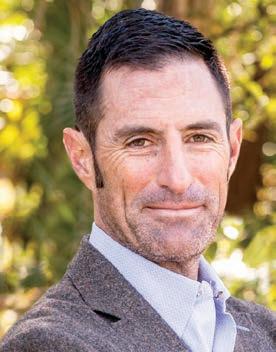
Capital

One additional aspect of their business that drove its reshoring effort was the seasonality of demand for their products. With spikes around holiday parties, wedding season, and summer fashion, the Company could not afford unforeseen shipping delays.
Yet reshoring is far from plug-and-play. It requires sourcing domestic facilities, investing in equipment and systems, hiring skilled labor, and ensuring cost-efficiency—steps that take time, planning, and capital.
After surviving COVID-induced supply chain issues and decrease in demand, the owner began looking into reshoring. With intensified geopolitical uncertainties and emerging tariff concerns, the owner decided the time was right to shift their operations and supply chain closer to home. The move would both improve margins and add American jobs.
One additional aspect of their business that drove its reshoring effort was the seasonality of demand for their products. With spikes around holiday parties, wedding season, and summer fashion, the Company could not afford unforeseen shipping delays. Retailers will cancel orders if the inventory is not available on time. Streamlining their supply chain to ensure product availability became essential to growth and profitability.
Simultaneously, the Company began searching for a new finance partner who would support their capital investment
JASON LIPPMAN nFusion
and offer greater borrowing availability against their assets. Their previous asset-based lender was not able to be flexible with the line of credit or provide additional capital needed to complete their reshoring move, and was not best suited to help the Company transition to domestic manufacturing. The lender had not invested the time to sufficiently understand their business, and, during a five-year relationship, the lender hadn’t visited the Company’s location once. Another factoring firm referred the owner to nFusion Capital.
From the outset, nFusion approached the relationship differently. The team visited the Company’s headquarters multiple times before finalizing the deal, gaining a firsthand understanding of operations, culture and strategy. nFusion was impressed by the operations as well as the owner’s dedication and innovation. Over the next several weeks, due diligence was completed to transition the lingerie-maker from the previous lender to nFusion Capital, with frequent communications to ensure client expectations were met and the transaction closed on time. The Company appreciated the business advisory role nFusion played, allowing it to move into the new facility without any adverse impact.
nFusion provided a $17 million factoring and inventory financing facility to support the Company’s decision to move its manufacturing to the U.S. and create over 30 new local manufacturing jobs. The funding also enabled the Company to sell more inventory at an increased profit margin. nFusion also helped institute a new cash-management system to help the Company manage their cash flow.
Today, the Company is not only manufacturing domestically, but thriving. With improved access to working capital, it has increased top-line revenue, taken advantage of seasonal opportunities, and positioned itself to better meet evolving market demands—all while bringing jobs back to the U.S.
In every transaction, nFusion plays a vital partnership role to ensure success of growth strategies. Owners, management teams, and sponsors need a patient capital partner, like nFusion, who understands the resources required to invest in and execute reshoring, near-shoring, or split-shoring strategies.
nFusion is proud to support businesses that are building a stronger, more resilient American manufacturing economy, helping them become more agile and cost-competitive. This is exactly the kind of growth story we’re here to help support.
Jason Lippman is the founder and chief executive officer of nFusion Capital, responsible for the firm’s overall strategic vision and service to our client base. He is passionate about entrepreneurship and creating financing solutions that help business owners realize their fullest potential. He launched the company with a unique approach to the world of business finance – he built a team of optimists who start from a position of
“yes we can” and aggressively work on behalf of their customers to ensure their success. Prior to founding nFusion, Jason was an entrepreneur and served as a growth agent for several companies in the factoring and asset-based lending market.
THE ANATOMY OF A DEAL
Rosenthal Capital Group Details a Recent Transaction Showcasing the Benefits of Non-bank Financing Alternatives
BY ROBERT SCHNITZER
Alternative lending has taken on a whole new meaning thanks to the dramatic growth of the private credit and alternative lending market in the U.S. over the past few years. As more and more traditional banks have tightened their belts and become more stringent in their lending practices, nonbank lenders have recognized the opportunity to fill that void. At a time when the economy is shaky at best and volatile at worst, businessowners are looking for lending solutions and a more efficient and flexible lending process.
A recent study by Deloitte looking at the actions of the 50 largest banks in the United States in the private credit space found that when banks took a step back from lending in 2023 because of market volatility, private credit managers stepped in to provide borrowers with stable funding and a more efficient lending process. In this environment, asset-based lending remains a great option to support businesses that find themselves in turnaround or those who are bouncing back from tough situations. It can be equally beneficial for growing businesses as well, as it’s a way to unlock more liquidity without putting a strain on operations.
“More and more, we’re seeing clients seeking out alternatives to traditional bank financing—and in some cases, even looking for financing that can pair well with existing bank loans,” said Paul Schuldiner, chief lending officer at Rosenthal Capital Group. “Some banks are scrambling to compete while others are finding ways to collaborate and partner with alternative lenders to help clients secure additional financing that complements existing funding already in place.”
This spring, Rosenthal Capital Group (RCG) was introduced to a company that found itself in one such difficult scenario. The New Jersey-based company was a large-scale manufacturer of graphic printing solutions and point-ofpurchase retail packaging and advertising displays for a diverse customer base of businesses. The company had received approval for a LOC and a Term Loan from a new bank and was in the documentation stage when the company’s management team issued an interim financial statement that reflected a downturn in the business. The bank became nervous, pulled
the approval and walked away from the transaction in the middle of the loan documentation process—a shock to the management team and an unexpected interruption in their business plans.
After incurring significant due diligence and legal costs from their work with the bank, the company was now in the tough position of having to find a new lender on short notice that would be willing and able to get them to a loan closing quickly.
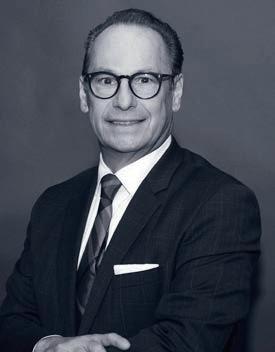
ROBERT SCHNITZER Rosenthal Capital Group
Knowing how critical flexibility and speed to close were to the client, the company’s long-time consultant introduced the management team to RCG. With the assistance of the consultant, RCG was able to get comfortable with management as well as the company’s financial condition and business plan forecast.
As a result, RCG was able to provide the company with a $9.5 million facility, which included a $4 million revolving line of credit and a $5.5 million term loan. At closing, when the parties learned of an affiliate loan that the existing lender wanted to refinance, without hesitation, RCG approved an additional $1 million within 24 hours to cover that additional liability.
“This transaction was not our typical structure, but with a little creativity and flexibility, we were able to limit RCG’s risk so that we could provide the additional financing the client needed to pursue their growth plans,” said Schuldiner.
In situations like this one, flexibility is the name of the game. A soundly structured asset-based lending facility can help clients manage cash flow more effectively, fuel growth or even make strategic acquisitions down the line. For businesses experiencing periodic market volatility and variability, assetbased lending with an alternative lender can be just the solution they need. The key for lenders in this competitive market is to be flexible, get creative, look beyond just the numbers on the balance sheet and find ways to provide less restrictive financing solutions.
Robert Schnitzer is senior vice president of Business Development at Rosenthal Capital Group (RCG).
THE ANATOMY OF A DEAL
From Covenant Breach to Confidence: How SCP Repositioned a Leading Food Manufacturer for Growth
BY BOB RIISKA AND CHAS SCHLAACK
In the often-unpredictable world of commodity-based manufacturing, a leading food manufacturer (the “Company”) found itself at a crossroads in late 2024. A provider of premium ingredients for private label and branded consumer package goods, the Company had built a strong reputation for its commitment to product quality and food safety. However, several financial and operational challenges brought the Company to the brink of covenant violations and strained its relationship with its lender.
This is the story of how SierraConstellation Partners (“SCP”) helped the Company regain its financial footing, restore transparency with stakeholders, and re-establish credibility— ultimately positioning the Company for a more resilient and informed 2025.
Situation: Liquidity Pressures, Forecast Failures, and Eroding Trust
The Company entered 2024 grappling with significant EBITDA attrition, driven, in part, by growth investments that hadn’t yet materialized into profitability. Compounding the challenge was the Company’s weakened liquidity position, which resulted from a defensive commodity position the Company had taken that left it overexposed with the wrong type of inventory and unable to recover working capital quickly enough.
By the end of 2024, the Company had failed to meet certain fixed charge coverage and liquidity covenants, prompting serious concerns from its lender. Financial forecasts were regularly missed, and the reporting packages—especially borrowing base certificates—were inconsistent, error-prone, and time-consuming. Confidence in management’s ability to deliver reliable financial information had deteriorated.
Recognizing the need for outside expertise, the Company retained SCP to provide operational and financial clarity to both internal leadership and external stakeholders. The mandate included an assessment of the Company’s financial health, the development of a reliable three-statement model,
and an evaluation of the company’s finance and accounting capabilities.
Solution: Building Transparency, Rigor, and Forward Visibility
SCP immediately set out to bring greater financial clarity to the Company’s stakeholders. At the heart of the engagement was the creation of a detailed three-statement financial model that offered not just income statement projections but also balance sheet and cash flow forecasts—with forward-looking covenant calculations. This model provided much-needed transparency to both management and the lender, while also serving as a planning tool to help navigate a complex operating environment.


One of the first revelations from SCP’s work was that EBITDA attrition had been driven by certain growth-oriented investments that had not been clearly communicated to the lender. These were rational business decisions—but the lack of proactive explanation created confusion and distrust. SCP helped the Company unpack and articulate these drivers in a way that clarified past performance and laid the groundwork for future alignment.
Additionally, SCP worked closely with the Company’s finance team to streamline and improve reporting templates. These improvements not only reduced the time burden on internal resources but also enhanced accuracy and consistency, addressing one of the lender’s primary pain points.
The overexposed commodity position was a looming concern, but not an unsolvable one. SCP collaborated with Management to validate a strategy for unwinding the position over the course of 2025. By demonstrating that the issue was non-recurring—and showing that the Company had a corrective action plan—SCP helped ease lender concerns and reframe the narrative from crisis to course correction.
Lastly, SCP conducted a thorough review of the company’s
BOB RIISKA SierraConstellation Partners
CHAS SCHLAACK
SierraConstellation Partners
finance and accounting structure. The organization lacked a dedicated FP&A role—something critical for a business operating in volatile markets. SCP recommended creating a Director/VP of FP&A role and assisted in crafting the job description and go-to-market strategy for the hire.
Results: Restored Trust, Improved Forecasting, and Strategic Growth Initiatives
The most immediate benefit of SCP’s engagement occurred during an in-person meeting between Company’s executive management and key lender stakeholders. Armed with a credible assessment, a robust financial model, and a clear path forward, the Company was able to reset expectations and rebuild trust.
The new three-statement model enabled the Company to proactively identify and plan for potential challenges in 2025, creating internal alignment and external confidence. The clarity it provided transformed the way the Company communicated with its lender, offering a shared framework for structured, forwardlooking discussions.
The recommendation to add an FP&A role was swiftly acted upon. Within weeks, the Company began recruiting for a Director/ VP of FP&A—seeking SCP’s input not only on the job specifications but also on recruiting avenues and candidate profiles. This role will help the Company strengthen its forecasting discipline and financial strategy for years to come.
Takeaway: From Firefighting to Forward Momentum
This engagement illustrates the impact of financial transparency, proactive communication, and operational clarity during times of distress. What began as a reactive effort to stabilize a lender relationship quickly evolved into a strategic transformation of the Company’s finance function.
Through detailed modeling, hands-on collaboration, and actionable recommendations, SCP not only helped the business navigate a challenging chapter—it helped it build the tools, processes, and relationships needed to write a stronger next one.
In today’s capital-constrained environment, trust and transparency are paramount. For this industry leader, this deal was more than a financial turnaround—it was a foundational reset.

The recommendation to add an FP&A role was swiftly acted upon. Within weeks, the Company began recruiting for a Director/VP of FP&A—seeking SCP’s input not only on the job specifications but also on recruiting avenues and candidate profiles.
Perhaps most notably, SCP’s involvement evolved from a tactical engagement into a Trusted Advisor relationship with the Company’s owner. In the weeks following the lender meeting, SCP was asked to weigh in on additional strategic initiatives, including the evaluation and potential implementation of forecasting software—an initiative that would further institutionalize financial rigor and enhance the Company’s planning capabilities.
Bob Riiska is managing director at SierraConstellation Partners.
Chas Schlaack is senior director at SierraConstellation Partners.
THE ANATOMY
OF A DEAL Simplifying Equipment Finance to Empower Middle-Market Growth
BY DON SCHIFFER
How Utica Equipment Finance Delivers Speed, Flexibility, and Results Across Industries
In today’s unpredictable credit environment, middle-market operators need more than just capital—they need a lender that can move quickly, structure creatively, and deliver certainty.
That’s where Utica Equipment Finance steps in.
As a principal lender providing direct equipment financing solutions from $2 to $50 million, Utica offers clients a streamlined, asset-focused alternative to traditional bank credit. By tailoring each transaction around the collateral— not demanding credit expectations or rigid covenants—Utica helps businesses satisfy senior lenders, simplify their capital structure, lower their payments, and enable growth.
Over the past 20 years, Utica has funded hundreds of transactions across industries like manufacturing, construction, mining, oil field services, logistics, waste management, and printing—each designed to improve cash flow and support long-term objectives.
“We’re not in the business of saying no,” said Ed Stolarski, president of Utica Equipment Finance. “Our team understands collateral of all types, knows how to move fast, and can structure capital leases, term loans, and sale leasebacks that make sense—even in complex or time-sensitive scenarios.”
Utica’s team includes asset management and valuation experts, as well as in-house attorneys who help accelerate transaction closings.
Delivering Speed in Precision Manufacturing
When a precision manufacturer pursued the acquisition of two synergistic businesses, time was critical. Utica responded with a $7.5 million Capital Lease, secured by clean manufacturing and tooling equipment, to fund the purchase and provide working capital.
The borrower—focused on high-precision components for agriculture, aerospace, and construction—needed more than just a check. They needed a partner who understood industrial assets and could work around tight deadlines. Utica’s flexible structure allowed the company to consolidate operations, improve margins, and take its capabilities to the next level.
Consolidating Debt for a Waste Services Leader In the Midwest, a construction waste hauling and environmental
services provider was burdened with debt from 60 separate lenders. Utica stepped in with a $7.5 million Capital Lease, secured by trucks and containers, to refinance the company’s obligations into a single, streamlined facility.
The impact? Lower cost of capital. Improved monthly cash flow. Fewer headaches. Utica’s ability to wrap multiple asset types into one structure helped the operator regain focus on operations—and position itself for future expansion.

DON SCHIFFER Utica Equipment Finance, LLC
Supporting Multi-Brand Growth at Scale
For a national marketing and printing firm with 30+ locations and 17 subsidiaries, Utica funded an $18.5 million Capital Lease to support growth across commercial print, signage, direct mail, and e-commerce verticals.
This customized lease covered both debt consolidation and new working capital, secured by printing and support equipment. By tailoring the structure to accommodate diverse business lines and layered asset pools, Utica helped the borrower reduce complexity and refocus on scaling its platform.
Enabling Resilience in Energy & Infrastructure
Utica’s deep experience in asset-heavy industries made it the right fit for a $3.1 million Capital Lease to a Permian Basin oilfield and aggregates provider. The deal, secured by construction machinery and processing assets, helped refinance existing debt and unlock working capital for field operations.
Similarly, a $1 million Capital Lease in Colorado enabled an oilfield completions and fluid services firm to acquire new frac pumps, nitrogen trucks, and coil tubing equipment—expanding capacity just as industry demand rebounded.
Both transactions reflect Utica’s agility in structuring around mobile, mixed-use equipment—especially when speed and flexibility are paramount.
Financing Long-Term Success in Mining
Some clients come back again and again. That was the case with a multi-location coal mining company, where Utica recently closed a $1.625 million Capital Lease—the fifth schedule in an ongoing partnership. The lease funded equipment to support expansion and operational upgrades.
Utica’s familiarity with the industry, fast credit decisions,
and commitment to continuity has made it a go-to financing partner for clients in cyclical sectors like mining, construction, and energy.
Why Utica?
Across every deal, Utica brings the same advantages: No financial covenants
Limited credit reliance
Collateral-first underwriting
Flexible amortization schedules
Fixed and floating rate options
Terms from 3 to 5 years, with amortization up to 6
More importantly, Utica moves quickly—because business doesn’t wait. Whether the need is refinancing, recapitalizing, or acquiring new assets, Utica delivers responsive capital tailored to each borrower’s credit profile and asset base.
“Middle market companies deserve customized, commonsense financing,” said Ed Stolarski. “Our team makes it simple—and we back it with speed, experience, and direct capital.”
About Utica Equipment Finance
As associate of credit and underwriting at Utica Equipment Finance, LLC, Don Schiffer is responsible for evaluating and underwriting commercial lease and loan requests. He interacts with clients, referral sources, and financing partners to address any credit or risk management issues for complex transactions during the underwriting process. He brings extensive experience in finance, tax, and accounting methods. Before joining Utica Equipment Finance, he was a senior tax consultant with Deloitte Tax LLP and earned his B.S. in accounting and finance at Immaculata University.

Utica’s familiarity with the industry, fast credit decisions, and commitment to continuity has made it a go-to financing partner for clients in cyclical sectors like mining, construction, and energy.
Utica Equipment Finance is a fullservice equipment finance and leasing provider, delivering direct capital solutions as a principal lender to middle market companies across the U.S. The team specializes in situational lending, with structures including capital leases, true/tax leases, term loans, and sale leasebacks.
Utica Equipment Finance is a Utica Leaseco company, part of a platform founded by David Levy and Craig Stormer, now celebrating its 20th anniversary in 2025. With decades of experience in fixed assets, Utica supports industries including manufacturing, construction, mining, oilfield services, transportation, and more. Learn more at uticaef.com
THE ANATOMY OF
A DEAL A Strong Vision And Experienced Management Team Are Key To Launching A New Lending Platform
BY DAVID KOSHENINA
Starting a commercial finance company is an aspiration for many professionals who have spent years working for large financial institutions. The entrepreneurial spirit is particularly strong in the world of finance, where working for large organizations can be challenging for leaders who see missed opportunities and inefficiencies holding them back.
We know that the growth of private credit presents a significant opportunity. Many private debt funds, BDCs, insurance companies, and diversified asset managers are looking for ways to deploy capital at attractive risk returns. To complement the middle-market cash flow businesses, many are investing in the non-bank asset-based lending or equipment finance space. The equipment finance space is attractive to the private credit market for several reasons — fully funded amortizing loans (do not have to deal with the unfunded component of loans), a liquid and efficient institutional market via term securitization, a simpler servicing and operational model than providing revolving lines of credit, and loans/leases supported with a first lien on equipment.
However, to successfully launch a new lending platform, several key factors are necessary. An experienced management team with a demonstrated track record of success and proven capabilities in sales, credit, and operations, is essential. Pairing up with the right equity or junior capital provider is also crucial. Defining the right deal strategy and terms, which include target markets, risk tolerance, pricing/returns, ticket size, sales model, servicing, and investment horizon, are all vital.
A terrific example of how all these components can come together is the launch of Gordon Brothers’ Equipment Finance platform earlier this year. Gordon Brothers launched a commercial equipment finance offering to middle-market businesses seeking efficient equipment financing options on both a direct and indirect basis. The firm’s new offering complements the existing equipment finance business that provides structured, asset-focused leasing and lending solutions to companies experiencing operational and/or market challenges. Through the combination of these offerings, Gordon Brothers can now provide clients with a full suite of customized equipment financing solutions across the credit spectrum.
Norma Kuntz,
Chief Executive Officer
at Gordon Brothers, was
eager to expand the firm’s existing equipment finance offering to middle-market companies and entrusted the task to Bobby Campbell, head of Commercial Equipment Finance, and his team. The team brings over 20 years of experience in equipment financing, further strengthening Gordon Brothers’ ability to deliver value to clients.

DAVID KOSHENINA
Wells Fargo Lender Finance
The launch of the commercial equipment finance business allows Gordon Brothers to provide equipment loans, capital leases, and terminal rental adjustment clause (TRAC) and fair market value (FMV) leases. The firm works directly with middlemarket commercial companies, independent lessors, captive finance organizations, and bank-owned equipment financing groups.
Wells Fargo provided a senior secured revolving line of credit to help Gordon Brothers launch the platform. Arranging the senior debt and equity/junior capital provider can feel like the age-old question of the chicken or the egg, but in reality, bringing both of these components together is done in unison as they need to work together to support the specific strategy of the business.
Providing a line of credit to a start-up business can sometimes be challenging for traditional banks, but the Lender Finance team at Wells Fargo has helped entrepreneurs successfully launch specialty finance platforms for more than 25 years. The team focuses on understanding the vision of the leadership team and the new platform, along with underwriting to the policies to align with the future portfolio from a credit perspective. The Lender Finance team also recognizes that structuring the line of credit to fit the business is a moving target as every new platform adjusts as they establish themselves in the market. Wells Fargo looks forward to growing and evolving alongside Gordon Brothers.
David Koshenina is the division manager of the Lender Finance team at Wells Fargo. David has worked at Wells Fargo for 18 years. Prior to Wells Fargo, David worked in the restructuring group for Alvarez & Marsal, and in the FIG Investment Banking Group at Piper Jaffray. David graduated from the University of Wisconsin, Madison and has an MBA from The Anderson School at UCLA.
The below is a full list of organizations that are a member of the Secured Finance Network. For details, please visit our Member Directory.
1st Commercial Credit
Raul Esqueda
A/R Funding, Inc.
Brian Holden
ABLSoft Inc.
Nancy Lee
ABN AMRO Asset Based Finance N.V.
Arjan de Liefde
Accelerated Payments Canada Inc.
Neil McMillan
Access Business Finance, LLC
Douglas McDonald
Access Capital, Inc.
John Belling
Accord Financial Inc.
Simon Hitzig
Accounts Receivable Insurance (ARI)
Steven Schrull
Addleshaw Goddard LLP
Mike Davison
Advantage Business Capital
Wayne Coker
Aegis Business Credit, LLC
Mike Fussell
Aequum Capital Financial LLC
John Stanfield
AeroFund Financial, Inc.
Stephen Troy
Aird & Berlis LLP
Jack Goslett
Alba Wheels Up International LLC
Salvatore Stile II
Alleon Healthcare Capital
Ben Malyar
Allianz Trade
Lee Fahrenz
Allied Financial Corporation
Steven Gold
Alter Domus
Ellen Cook
Alterna Capital Solutions LLC
Stan Carpenter
AmeriFactors Financial Group, LLC
Angela Fiorentino
Amerisource Business Capital
Michael Monk
Apple Bank
Burt Feinberg
Ares Management LLC
Ryan Cascade
Assembled Brands
Michael Lipkin
Asset Based Lending Consultants, Inc.
Donald Clarke
Aurous Financial Services
Jeff Sirchio
Austin Financial Services, Inc.
Jason Anish
Bank of America Business Capital
Seth Benefield
Bank OZK
Michael Sheff
Bay View Funding
Glen Shu
BDC Capital Corporation
Kenneth Smith
BDO USA, P.A.
Baker Smith
Becker & Poliakoff
Paul Shur
Berkshire Bank
Mark Foster
Birch Lake Holdings, LP
Jack Butler
Blank Rome LLP
Lawrence Flick
Bluewater Transaction Advisors
Robert Bowles
BMO Commercial Bank ABL
Michael Scolaro
BNP Paribas
Guelay Mese
Boston Financial & Equity Corp.
Deborah Monosson
Breakout Finance
Ian Bradley
Briar Capital Real Estate Fund
Frank Goldberg
Bridge Business Credit
Rhett Rowe
Bridgeport Capital
Max Toledo
Buchalter
Robert Gillison
Cadence Business Finance
Norb Schmidt
Cahill Gordon & Reindel LLP
Tim Howell
Callodine Credit
Caitlin Sanders
Cambridge Savings Bank
Yvonne Kizner
Camel Financial, Inc.
Helena Sopwith
CapFlow Funding Group
William Gallagher
Capital Foundry, LLC
John Fox
2025
Capital One, N.A.
Timothy Tobin
Carob Financial
Aharon Tarnavsky
Cash Flow Resources, LLC
Kevin Laborde
CB&S Business Capital
Michael Knuckles
Celtic Capital Corporation
Mark Hafner
Cerebro Capital
Christopher Dalo
Change Capital
Raffi Azadian
Chapman and Cutler LLP
Nicole Krol
Charter Capital
Joel Rosenthal
Chiron Financial LLC
Candice Hubert
Choate Hall & Stewart LLP
John Ventola
CIBC
Bruce Denby
CIT
Michael Hudgens
Citibank, N.A.
Shane Azzara
Citizens Bank
Brent Hazzard
CODIX
William Quinn
Commercial Finance Partners
Darren Palestine
Commercial Funding Inc.
James Baugh
Cost Reduction Solutions
Denise Albanese
CR3 Partners
James Katchadurian
Crossroads Financial
Lee Haskin
CSC
Paul Schultz
Culain Capital Management LLC
James Franz
Dare Capital
Cole Harmonson
Downtown Capital Partners, LLC
Gary Katz
Dwight Funding
Ben Brachot
Eastern Bank
Donald Lewis
eCapital Corp.
Steve McDonald
Eclipse Business Capital
Martin Battaglia
Edge Capital
Meredith Carter
Eisner Advisory Group LLC
Robert Katz
Entrepreneur Growth Capital, LLC
Dean Landis
Equify Business Funding
Kei Lehigh
Express Trade Capital
Mark Bienstock
Faegre Drinker Biddle & Reath LLP
Breia Schleuss
FGI
Sami Altaher
Fifth Third Bank
David Drury
Finley Technologies, Inc
Josiah Tsui
First Bank
Michael Maiorino
First Business Bank
Heather Hayward
First Eagle Alternative Credit
Lawrence Klaff
First Horizon Bank
Kevin Beeson
First Turn Capital
Chad Godwin
FirstLine Funding Group
David Ciccolo
Flagstar Bank
Robert Love
FlexFactor
Rehman Baig
Focus Management Group
J. Tim Pruban
Fortress Investment Group
Ian Schnider
Forvis Mazars
Gary Litvak
Franklin Capital Network
Susan Duckett
FrontWell Capital Partners
John Ho
Frost Brown Todd LLP
Michael O’Grady
FundThrough
Steven Uster
Garrington Financial Corp.
Tammy Kemp
Gateway Acceptance Co.
Robert Curtis
Gateway Trade Funding
Thomas Novembrino
Gibraltar Business Capital, LLC
Scott Winicour
Goldberg Kohn Ltd.
Richard Kohn
Goodman Capital Finance
Bret Schuch
Gordon Brothers
Frank Grimaldi
Goulston & Storrs PC
Jesse Rubinstein
Great Elm Specialty Finance
Michael Keller
Great Rock Capital
Jenn Cronin
Greenberg Traurig, LLP
David Kurzweil
Gulf Coast Business Credit
Wade Hladky
Harney Partners
James Harney
Haversine Funding LLC
Genevieve Merritt-Parikh
Haynes and Boone, LLP
Timothy Johnston
Hedaya Capital
Alfred Hedaya
Hilco Global
Gary Epstein
Holland & Knight LLP
Wade Kennedy
Hovde Group, LLC
Tim Stute
HSBC Business Credit Inc.
Thomas Getty
Huntington Business Credit
Guy Camerlengo
Hyper Valuation Services, LLC
Jonathan Deptula
IDB Bank
Christopher Dowd
InterNex Capital
Lin Chua
Iron Horse Credit LLC
Neil Wolfe
J & D Financial (West Coast) Corp.
David Carmel
J D Factors LLC
Matthew Johnson
JPalmer Collective
Jennifer Palmer
JPMorgan Chase Bank
Jim Wells
KeyBank Business Capital
Michael Panichi
King Trade Capital
Edward King
Knight & Associates, LLC
Tim Knight
Kore Capital Corporation
Kwesi Rogers
KPMG LLP
Andrea Beirne
Latham & Watkins, LLP
Jennifer Ezring
Legacy Corporate Lending LLC
Clark Griffith
Lenders Funding, LLC
Robert Zadek
Lendscape
Chris Coleman
Lighthouse Financial Corp.
Brad Leach
LoanWatch Inc.
Tim York
LOEB
Howard Newman
Loeb & Loeb LLP
Miriam Cohen
M&T Bank
Albert Spada
Magnolia Financial, Inc.
Marc Smith
Marco Capital
Peter Spradling
Match Factors, Inc.
Eric Belk
Mayer Brown LLP
Alex Dell
McGlinchey Stafford PLLC
Susan VanWingen
McGuireWoods LLP
Penny Zacharias
McMillan LLP
Jeff Rogers
Merchant Financial Group
Scott Adler
MidCap Business Credit, LLC
Steven Samson
MidCap Financial Services, LLC
Bradley Kastner
MidFirst Business Credit
John Nooney
Mitsubishi HC Capital America
Michael Semanco
Mitts Law, LLP
Maurice Mitts
Mizuho Securities USA LLC
Vincent Repaci
Monroe Capital LLC
Ted Koenig
Morgan, Lewis & Bockius LLP
Marshall Stoddard
Moritt Hock & Hamroff LLP
Marc Hamroff
Mountain Ridge Capital
Craig Winslow
MUFG Bank, LTD
Brian Gingue
NautaDutilh
Elizabeth van Schilfgaarde
Newpoint Advisors Corporation
Kenneth Yager
nFusion Capital Finance
Amity Mercado
North American Capital Corp.
Steven Roth
Norton Rose Fulbright
Michael Black
2025
Novo Advisors
Sandeep Gupta
Ocean Bank
Ignacio Hernandez
Octet Finance Pty Ltd.
Clive Isenberg
Old National Bank
Jeffrey Skinner
Otterbourg P.C.
David Morse
Oxford Commercial Finance
Robyn Barrett
Paladin Management Group
Scott Avila
Parker, Hudson, Rainer & Dobbs LLP
Bobbi Acord Noland
Pasadena Private Lending
Michael McAdams
Pathward
Rich Flamang
Paul Hastings LLP
Katherine Bell
Peapack-Gladstone Bank
Patrick Brocker
Pitney Bowes Bank
Christopher Johnson
PKF O’Connor Davies
Patrick Diercks
PL Trade Finance
Fernando Vela
PNC Business Credit
Paula Currie
Porter Capital
John Cox Miller
Prestige Capital
Stuart Rosenthal
Provident Bank
Kenneth Kaestner
Quasar Capital Partners Inc.
Brian Center
RA Capital Funding, LLC
Gregg Rubin
RedRidge
Cory Ryan
Regions Business Capital
Courtney Jeans
RelPro
Shivan Persad
Republic Business Credit
Robert Meyers
Republic Capital Access, LLC
Edward Stucky
Resilience Insurance Analytics
Greta Pedraza
REV Capital
Loren Shifrin
Riemer & Braunstein LLP
Jaime Koff
Riveron
Richard Hatley
Rockland Trust
Joseph Herzog
Rosenthal Capital Group
Paul Schuldiner
Sallyport Commercial Finance, LLC
Nick Hart
Scalable
Daniel Olson
Seacoast Business Funding, a division of Seacoast Bank
Jay Atkins
SG Credit Partners
Charlie Perer
Sidley Austin LLP
James Snyder
Siemens Financial Services
Jeffrey Iervese
Siena Lending Group
Scott Elliotto
SierraConstellation Partners LLC
Robert Riiska
Single Point Capital
Susan Leopold
Sky Business Credit, LLC
Gail Reints-Pratl
SLR Business Credit
Jeffrey Goldrich
SLR Credit Solutions
Kerri McNeil
SLR Healthcare ABL
Mark Roscioli
Smith and Wilkinson
Stephen Peary
Solifi
Michelle Lansdowne
Southeastern Commercial Finance, a Renasant Bank Company
Patrick Trammell
STAT Recovery Services, LLC
Casey Roberts
State Financial Corporation
Gary Reiss
Stonebriar Commercial Finance
Steve White
Stradley Ronon Stevens & Young, LLP
Michael Bonner
Tauber-Arons Auctioneers & Appraisers
Anthony Arons
TD Bank
Joseph Nemia
Tech Capital, LLC
Hank Noon
Tech Cargo, LLC
Ernesto Vila
Texas Capital Bank
Chris Capriotti
The Alta Group / Independent Equipment Company
Carl Chrappa
The Brownstein Corporation
Howard Brownstein
The Interface Financial Group
George Shapiro
ThinkingAhead Executive Search
Trinity Taylor
Third Coast Commercial Capital, Inc.
Michelle Myers
Third Eye Capital Corp.
Arif Bhalwani
Thirdmark Capital LLC
Jacob Ladner
Thompson Coburn LLP
Leonard Podair
Tiger Capital Group
Michael McGrail
TradeCap Partners
Bryan Ballowe
Tradewind International Inc.
René Pastor
Troutman Pepper
Justin Wood
Truist
Chris Curtis
UMB Capital Finance
Greg Carasik
Umpqua Bank
Christina Hsu
United Community Bank
Caleb McFaddin
Univest Bank and Trust Co.
Bill Wilson
US Bank Asset Based Finance
John Freeman
US Capital Global
Charles Towle
Utica Leaseco, LLC
David Levy
Valley National Bu
siness Capital
John DePledge
Vion Investments
Stacey Schacter
Webster Business Credit
Abby Parsonnet
Wells Fargo Capital Finance
Stewart Hayes
Western Alliance Bank
Victor Le
White Oak Commercial Finance, LLC
Thomas Otte
WhiteHawk Capital Partners, LP
John Ahn
Wingspire Capital
William Bence
Winstead PC
Michael Bailey
Winston & Strawn LLP
Jordan Klein
Y&A Credit Services, LLC
Oliver Sutherin
Zions Bancorporation
Todd Eggertsen
How Assembled Brands Helped Janji Scale Its Mission-Driven Running Apparel Brand
BY MICHAEL LIPKIN

MICHAEL LIPKIN
Assembled Brands Capital
Janji is a mission-driven running apparel brand that creates high-performance gear inspired by the places runners explore and the people they meet along the way. Each season, Janji donates 2% of sales to fund water initiatives in the regions that inspire its collections. The company works with WRAP-certified factories and offers a fiveyear “run everywhere guarantee,” standing firmly behind its products.
One big factor that’s helped the business scale is Assembled Brands. “Janji believes in the power that great consumer products can inspire, create sustainable business models, and make the world a little better. So does Assembled. Without their patience, we couldn’t have gotten to where we are today,” says Janji CEO Dave Spandorfer.
Current Relationship with Assembled Brands
Janji currently maintains a senior secured line of credit with Assembled Brands, structured around the company’s inventory and receivables. The facility was established in 2019 with an initial commitment of $800,000 and has since been upsized to $2.5 million to support rising demand across both direct-to-consumer and wholesale channels.
The facility provides Janji with working capital to manage longer production timelines (great gear takes time to make!), capitalize on seasonal cycles, and build inventory to meet demand—all without equity dilution or rigid bank terms. This type of non-dilutive financing has become central to Janji’s ability to balance mission with growth. Michael Lipkin spoke with Janji CEO Dave
Spandorfer to learn more about the challenges the brand faces as a mission-driven SME, how a non-dilutive credit facility from Assembled Brands has supported their growth, and what the future holds as they continue scaling impact alongside performance.
What challenges do you face as a small and medium-sized enterprise in obtaining financing?
“What challenges doesn’t a small brand face in obtaining financing? As a growing business, we know we don’t always check the boxes for a lot of bigger banks. We also know our model isn’t perfect for institutional capital, and Mike (my co-founder) and I love that we still control the business. We care deeply about creating something sustainable— on the product side, the carbon offset side, and the financial side. Assembled Brands gets this. They’ve helped us scale by looking into future growth, not just past results. As we’ve scaled, so have our needs with Assembled. And they’ve been receptive to growing our line to support Janji’s demand.”
How did the relationship with Assembled Brands begin?
“We were introduced to Assembled Brands through a mutual connection! From the beginning, I knew they were the right fit. They understood our mission and the apparel industry, and most importantly, they came across as highcharacter people. They looked less at historicals and more at customer and unit economics, both of which showed that Janji has plenty of ability to scale. I knew they’d be partners in good times, but more importantly, in tough times—and pandemics and tariff placements have certainly borne that assumption out.”
they know tough times aren’t forever, and they see the ecosystem holistically, and not in a zero-sum way. They’re high-character capital partners.”
How do you see the collaboration between Janji and Assembled Brands in the future?
“Despite uneasy consumer sentiment on a macro level, we continue to hit our plan and grow, which means we’ll also continue growing within Assembled Brands. We like to think not just about next quarter, but two, four, and ten years into the future—and I hope all of those future years are with Assembled Brands. They’ve gotten us this far in the past six years. By making sustainable gear—the best gear for the longest distance—we want to ensure our relationship remains strong, longterm, and built for a profitable, meaningful future.”

“I’ve worked with banks that are not true partners. I have friends who have worked with financial institutions that, because they weren’t long-term thinkers, helped bring the company down, throwing the baby out with the bathwater.”
Please comment on the value your relationship with Assembled Brands has brought to your business.
“I’ve worked with banks that are not true partners. I have friends who have worked with financial institutions that, because they weren’t longterm thinkers, helped bring the company down, throwing the baby out with the bathwater.
Assembled Brands is the opposite of that. They’ve helped us scale our direct and wholesale business through flexibility, communication, and line size adjustments. They’re responsive, not rigid, but most importantly, they look after their clients. They make introductions,
Janji’s partnership with Assembled Brands shows how missionaligned financing can help brands scale with integrity. Together, they’ve built a capital relationship rooted in flexibility, trust, and a shared vision for long-term success.
Assembled Brands Capital is a leading asset-based lender providing growth capital to businesses across the consumer products ecosystem. Offering credit lines up to $25 million, Assembled Brands delivers flexible financing solutions tailored to the needs of CPG brands, manufacturers, distributors, and co-packers. Facilities are structured around inventory and receivables, enabling companies to manage production cycles, working capital needs, and scale with confidence.
Michael Lipkin is the chief executive officer at Assembled Brands Capital. He brings deep experience in asset-based lending, underwriting, and portfolio management, spanning both traditional financial institutions and non-bank lenders. Since joining Assembled Brands, Lipkin has helped expand the firm’s credit platform and refine its working capital strategy for modern CPG businesses. LinkedIn: linkedin.com/in/michael-lipkin

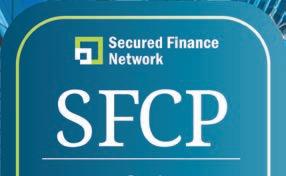
















Asset Smarter Capital Solutions





Unlock the upside your stakeholders deserve. Whether the goal is reorganization, recapitalization, or growth, our Hilco Global team of Asset Smarter professionals have the knowledge and insight to efficiently deliver tailored equity or debt solutions. This approach unlocks substantial upside at key business inflection points driven by liquidity challenges, debt maturities, distress, or other special

situations. When responsiveness and surety of success in completing a transaction are imperative to preserving and maximizing value for company stakeholders, nobody has more expertise or proven success than Hilco Global.
To learn more, contact Gary Epstein at 847.418.2712 or gepstein@hilcoglobal.com.
